The food of Portugal was key in our decision to move to Lisbon in 2019. Discover 33 must-try Portuguese food favorites to try during your visit so that you can fall in love with the best food in Portugal too.
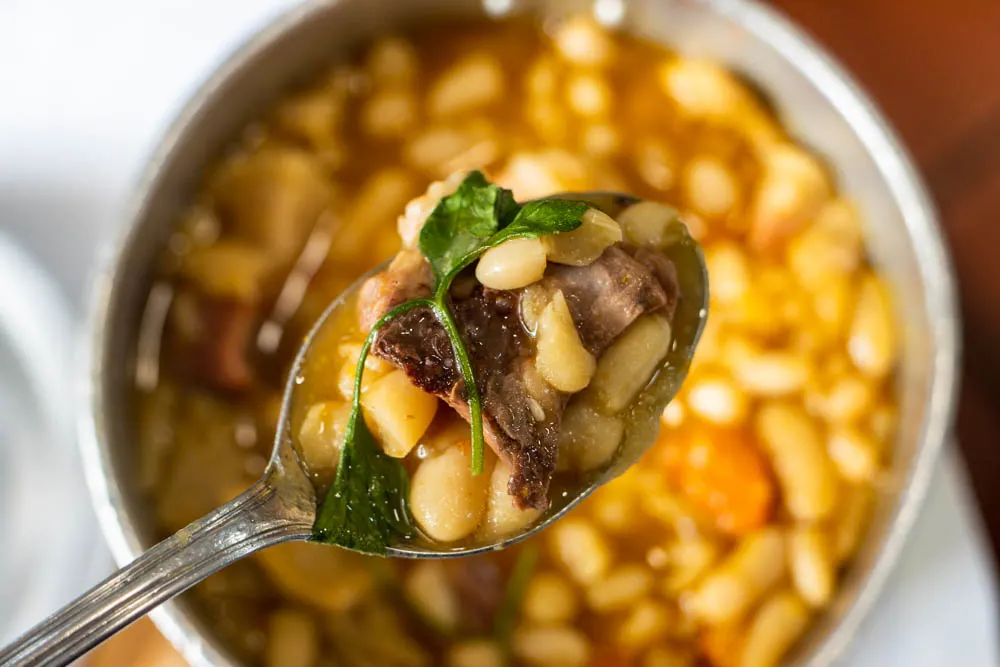
We fell for Portuguese food when we ate our first Pastel de Nata during our 2007 honeymoon in the Iberian country. When we moved to Portugal in 2019, that love grew and expanded to include a range of Portuguese dishes, both savory and sweet, that Portugal is known for around the world.
We never forgot our favorite Portuguese foods though it took us 12 years to make Portugal our home. We got a little thrill when we encountered Pasteis de Natas in cities like Macau and London. We got even bigger thrills when we enjoyed them after munching on Frango Assado (charcoal grilled Portuguese chicken) in cities like Cape Town and Montreal.
These food encounters motivated us to return to the land of Fado (soulful traditional music) and azulejos (Portuguese tiles). At the end of the day, there’s nothing like eating Portuguese cooking at the source.
Discover our favorite food cities in Portugal.
What Is Portuguese Food?
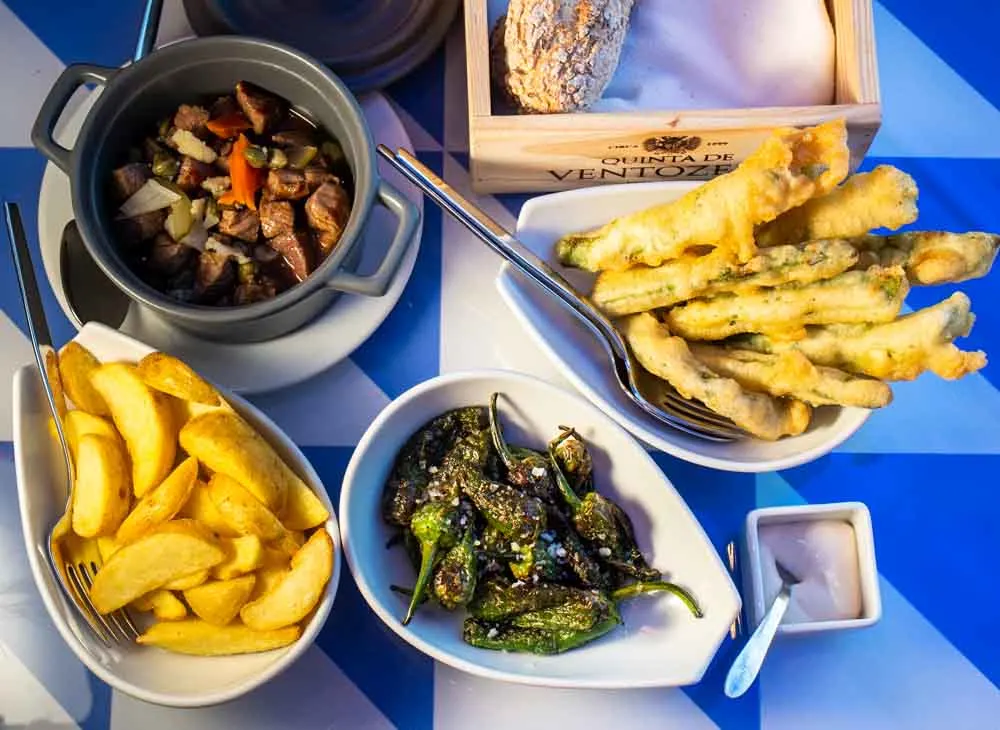
It’s not uncommon for people to confuse Portuguese food with Spanish food before they visit Portugal for the first time. The two countries are neighbors with a shared border and intertwined histories. However, it doesn’t take long for travelers to realize that the food of Portugal is emphatically unique.
The best food in Portugal is a reflection of both the country’s geographic location and its history of world exploration. Portugal was a trading powerhouse for hundreds of years, pioneering world exploration to create an empire built on the pepper trade.
Portuguese chefs and home cooks honor both geography and history every time they prepare food with locally sourced products and exotic spices. As a result, Portuguese food traditions are long and deep.
Discover our top tips for eating in Portugal.
Local Products
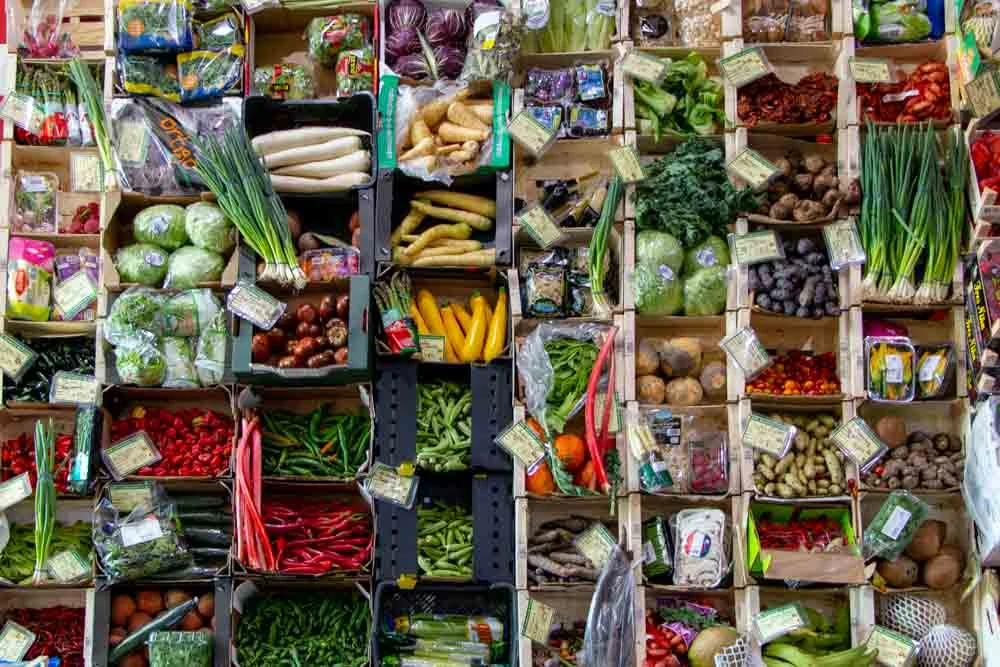
Portugal’s sprawling Atlantic coast provides a seemingly endless supply of fruits de mer like octopus, squid and shrimp.
The country’s agricultural abundance is equally impressive. Portuguese farmers grow a variety of produce including grapes for wine, grains for bread and olives for oil. Beyond the basics, local market swell with sweet, crunchy Portuguese apples from North of Lisbon in Alcobaça and citrus grown everywhere in the Algarve.
Like other countries in Southern Europe, Portugal produces some of the best cured meats and cheeses in the world. The Portuguese create amazing charcuterie and pork products from Acorn-fed black pigs and also use Portuguese cow, goat and sheep’s milks to produce high-quality cheeses.
Portuguese products like Presunto, Chouriço, Porco Preto, Azeitáo and Serra da Estrela compare favorably with meats and cheese from countries like France, Italy and Spain.
International Influence
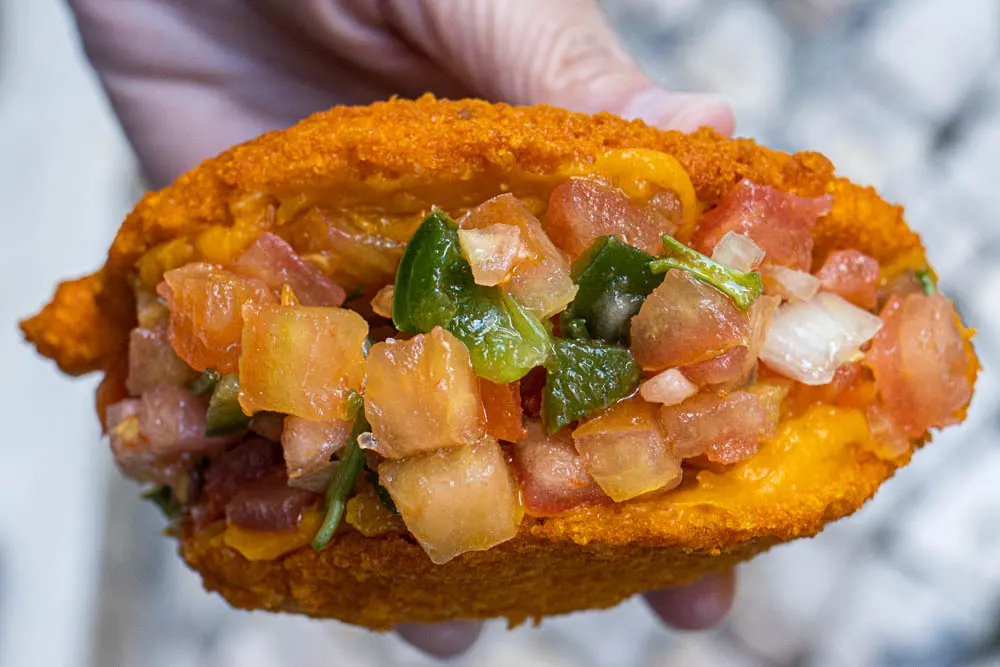
Portugal was a major player during the Age of Discovery, and the country continues to reap benefits from intrepid explorers from that time period. Not only did they ‘discover’ parts of Africa, South America and Asia, they also brought back spices and produce from destinations like Brazil, Macau, Mozambique and Goa. While common today, those items were unheard of before the Columbian Exchange in the 15th and 16th centuries.
Centuries later, Portuguese cuisine remains influenced by those global ingredients. Piri-Piri sauce, a condiment on every Portuguese table, is made with African chili peppers while many Portuguese menus feature Brazilian stews like Feijoada and drinks like the Caipirinha.
What to Eat in Portugal
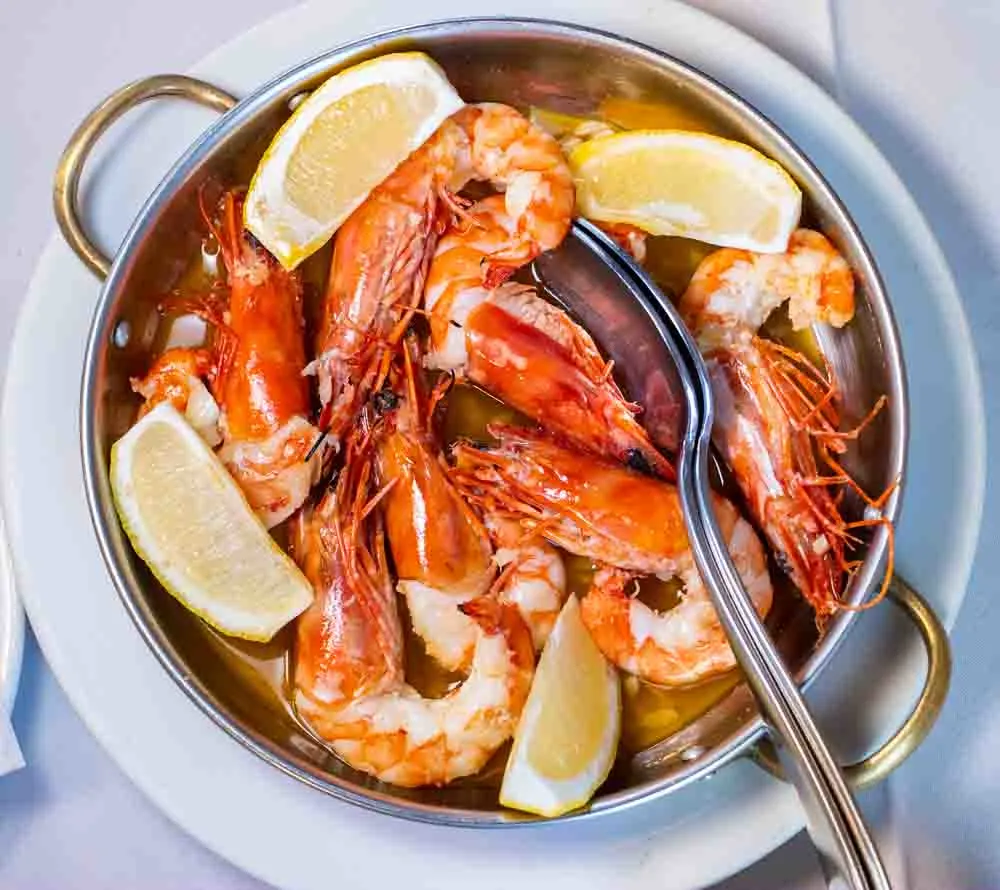
Although eating is one of the best things to do in Portugal, a traveler could hypothetically visit the country and miss all of the country’s best food dishes.
We’ve made it a personal mission to eat our way around the country from Algarvian beaches in the south to Porto’s hills in the north now that we live in Portugal. We’ve also chowed down in oceanside Cascais, romantic Sintra, fascinating Évora, historic Minho and our home city of Lisbon. We’ve even journeyed to the island paradise of Madeira.
Based on our on-the-ground research, we’ve narrowed our favorite Portuguese food and drink choices to 33 dishes that Portugal is most famous for serving. For usability, we’ve broken these choices into the following four categories:
Fun Fact
The following seven dishes were voted to be the Seven Wonders of Portuguese Gastronomy: Alheira Mirandela, Arroz de Marisco, Caldo Verde, Leitão da Bairrada, Queijo da Serra da Estrela, Pastéis de Belém and Sardinho Assada,
Traditional Portuguese Dishes
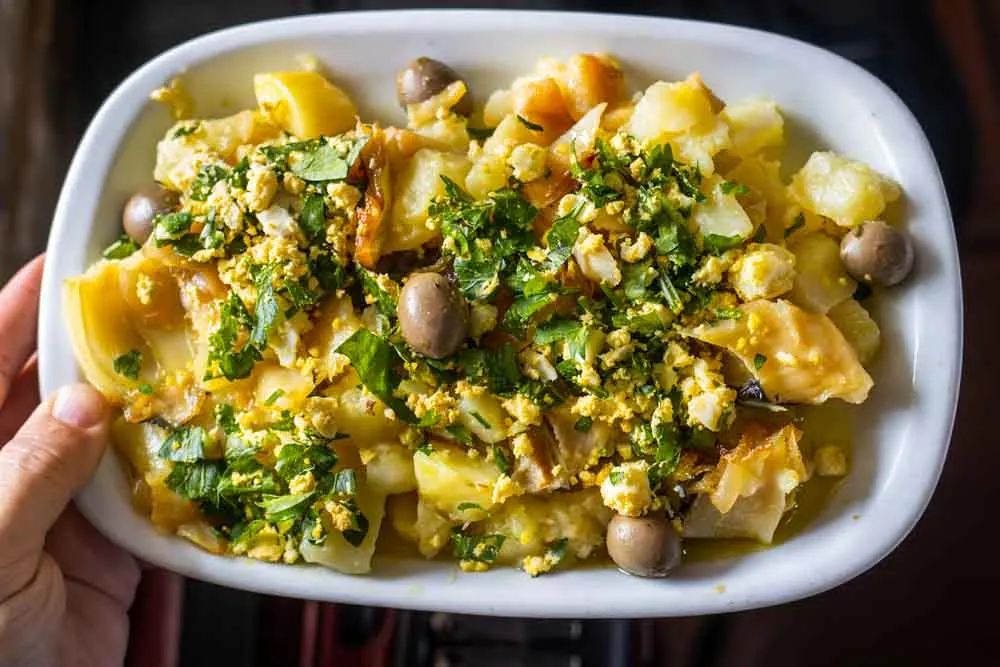
Curious food travelers can experience a range of traditional Portuguese dishes at tascas (taverns) as well as at neighborhood restaurants and snack bars. It doesn’t take long for them to realize that traditional Portuguese food is both easy to find and easy on the wallet.
We recommend that you start your Portugal food exploration with the following traditional dishes starting with Bacalhau, the national dish of Portugal:
1. Bacalhau
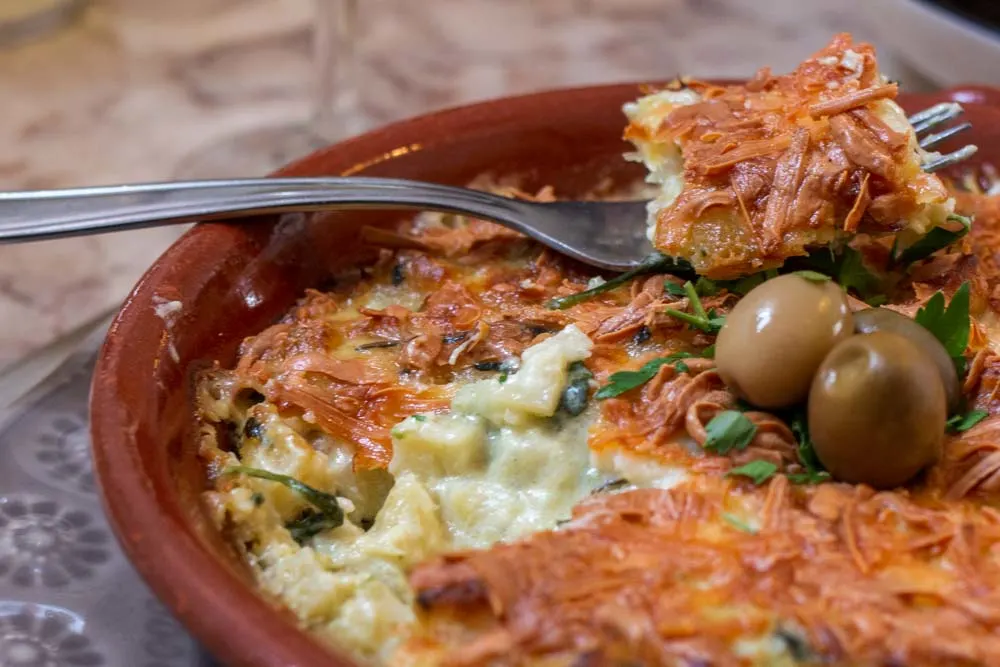
Bacalhau (salt cod) has been an integral part of the Portuguese diet for centuries and for good reason. Salting cod not only adds flavor but also removes the need for refrigeration. This preservation process was so impactful prior to refrigeration that cod has been called the fish that saved the world.
Despite the prevalence of refrigeration in modern times, bacalhau has not lost its popularity in Portuguese cuisine. The number of Portuguese dishes featuring salted cod is staggering, but none is more typical than Bacalhau à Brás. It’s so iconic that many consider it to be the Portuguese national dish!
Invented in Lisbon and especially popular on Fridays during Lent, Bacalhau à Brás is a mishmash of shredded salt cod, fried potatoes, eggs, onions and olives. The comforting dish is available at most tascas and casual eateries throughout Portugal. Ironically, most versions of the dish are topped with canned black olives – something we’re still attempting to understand in a country filled with olive orchards.
Fun Fact
Despite the plethora of fresh seafood available in Portugal, the country imports bacalhau from countries like Iceland and Norway. In fact, go anywhere in seafood-rich Southern Europe and you’re sure to find salt cod on the menu.
2. Pastéis de Bacalhau
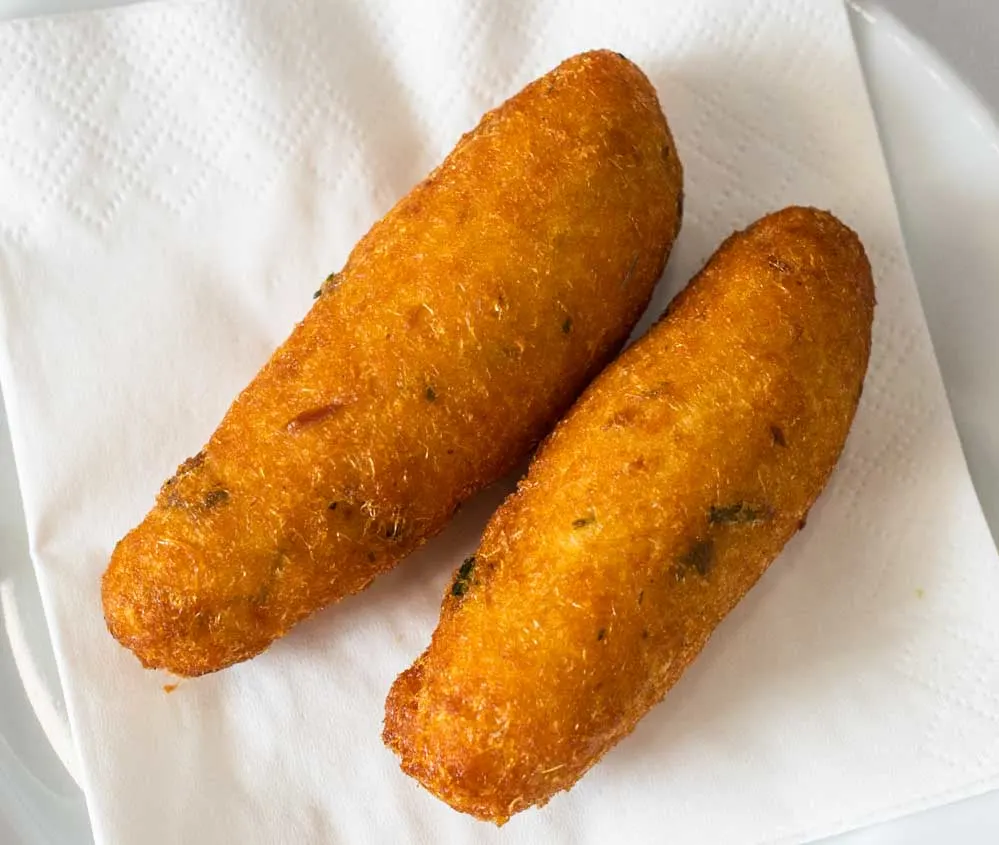
More than a snack and less than a meal, Pastéis de Bacalhau are fried cakes made with cod and potatoes instead of sugar and flour. In the north, these same cod fritters are called Bolinho de Bacalhau.
Regardless of the name, a Pastel de Bacalhau is a delight to eat hot out of the fryer. One bite into the crispy fritter reveals a creamy mixture made with bacalhau and potatoes as well as eggs and parsley. Three bites later, the tasty Portuguese appetizer will be nothing more than a happy memory.
Warning
One Pastel de Bacalhau is rarely enough and three are too many. In other words, plan to start your meal with two Pastéis de Bacalhau.
3. Sardinhas Assadas
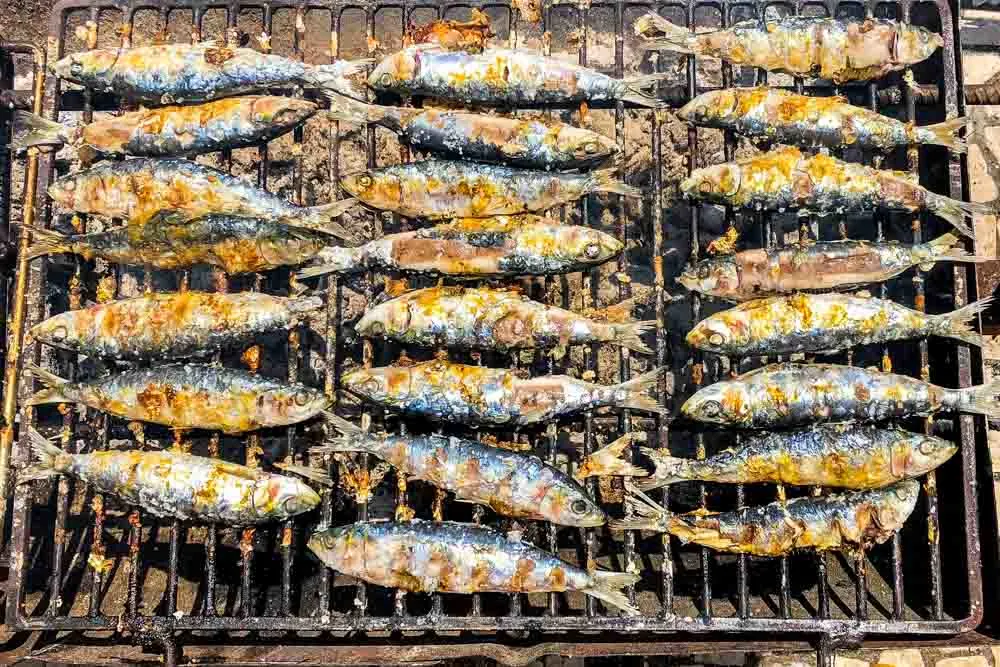
Cod isn’t the only popular finned fish in Portugal. Sardines take center stage on outdoor grills in warm summer months and hit the plate as a dish called Sardinhas Assadas.
The opposite of fancy, Sardinhas Assadas are grilled sardines seasoned with two Portuguese kitchen staples – salt and olive oil. Locals eat the entire sardine including the head, often with fried potatoes and rice, leaving boney carcasses as evidence of their debauchery. Many even rank Sardinhas Assadas among their favorite Portuguese fish dishes.
Pro Tip
Don’t miss the Feast of St. Anthony if your summertime visit coincides with the annual June festival that celebrates sardines.
4. Conserveiras
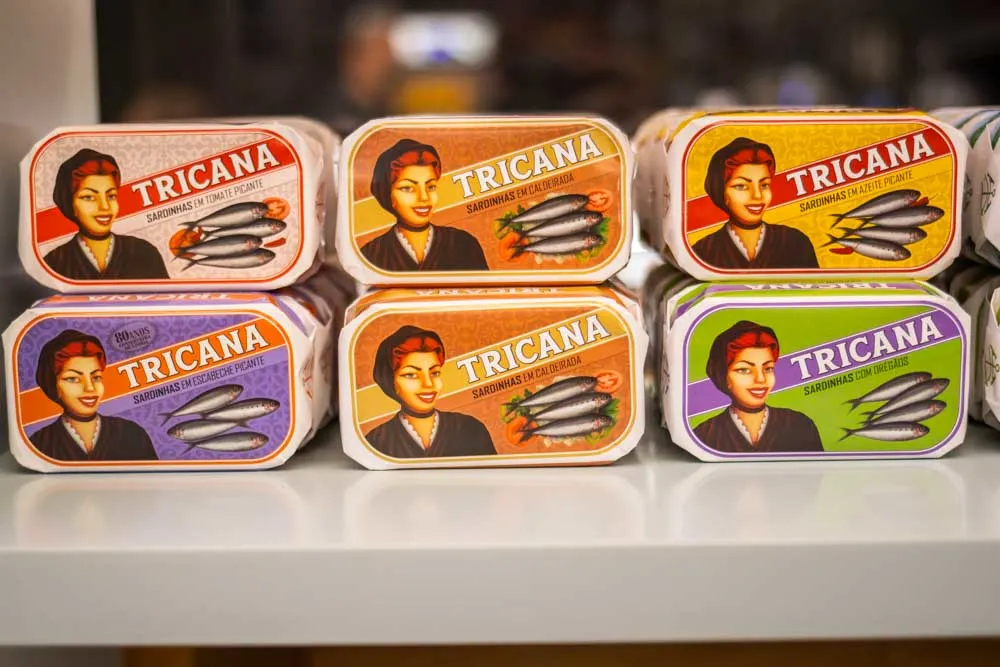
Conserveiras (canned tins of fish) offer a popular alternative to freshly grilled fish in Portugal. Far from a flash in the pan (or should we say can?), canning fish has been a ‘thing’ in Portugal since 1853 when Ramirez opened the country’s first commercial cannery in Vila Real de Santo Antonio. Ramirez is now the longest operating cannery in all of Europe.
Modern-day Portuguese canneries preserve a variety of freshly-caught seafood with olive oil and tomato sauce. Considered to be both a healthy everyday food and a delicacy, the final product is readily available at grocery stores, tourist shops and upscale restaurants.
Popular conserveiras include decoratively designed cans of atum (tuna), sardinhas (sardines), cavala (mackerel) and and anchovos (anchovies). More exotic selections include lulas (squid), polvo (octopus) and mexilhões (mussels).
Pro Tip
Buy conserveiras as edible souvenirs. You can buy tins decorated with art deco designs at shops like Can the Can, Comur, A Conserveira de Lisboa and A Vida Portuguesa at Lisbon’s Time Out Market.
5. Arroz de Pato
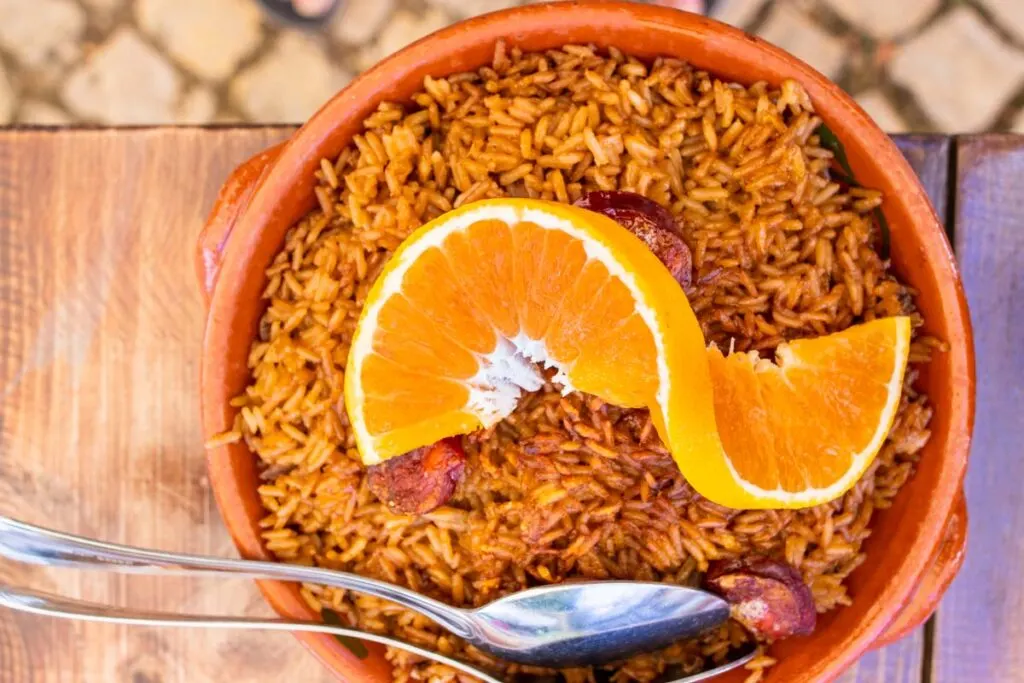
Rice is a key ingredient in numerous Portuguese dishes, both savory and sweet, but none is more iconic than Arroz de Pato (duck rice). Locals have eat the traditional 10-century-old Braga dish both at home for special occasions and at neighborhood restaurants for hearty lunches.
Many countries serve versions of duck rice but add a their own twists. Made with duck and rice, Portugal’s version is no exception…
Portuguese chefs add slices of smokey chouriço before baking baking Arroz de Pato in the oven. They then top it with fresh orange slices. The result is deeply flavorful and downright delicious.
Follow our Arroz de Pato recipe and cook the Portuguese rice dish at home.
6. Cataplana de Marisco
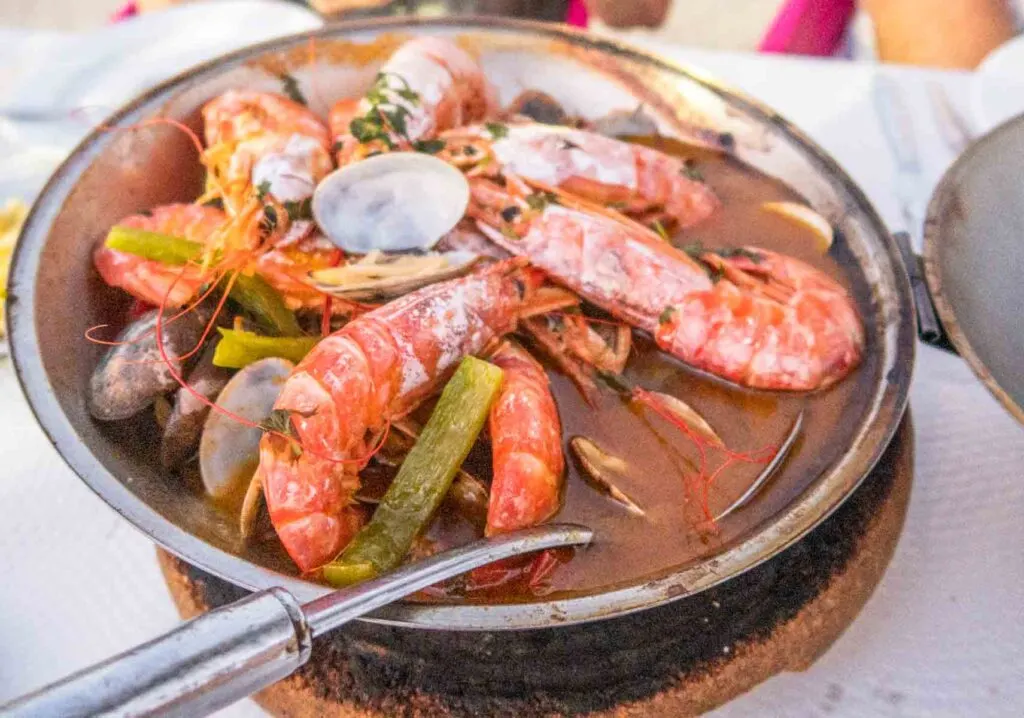
The word cataplana has two meanings in Portuguese. Used to describe clam-shaped copper frying pans, the word also describes dishes prepared in the metal vessel.
Originally created in the Algarve, Cataplana de Marisco is the most decadent cataplana and the one to order. This dish combines local ingredients like onions, tomatoes, peppers, olive oil and white wine and adds a melange of seafood including mussels, shrimp and clams.
Pro Tip
Some chefs add arroz and chouriço to Cataplana de Marisco, elevating the Portuguese seafood dish to a seafood feast. Don’t turn down this option if you see it on a Portuguese menu.
7. Caldo Verde
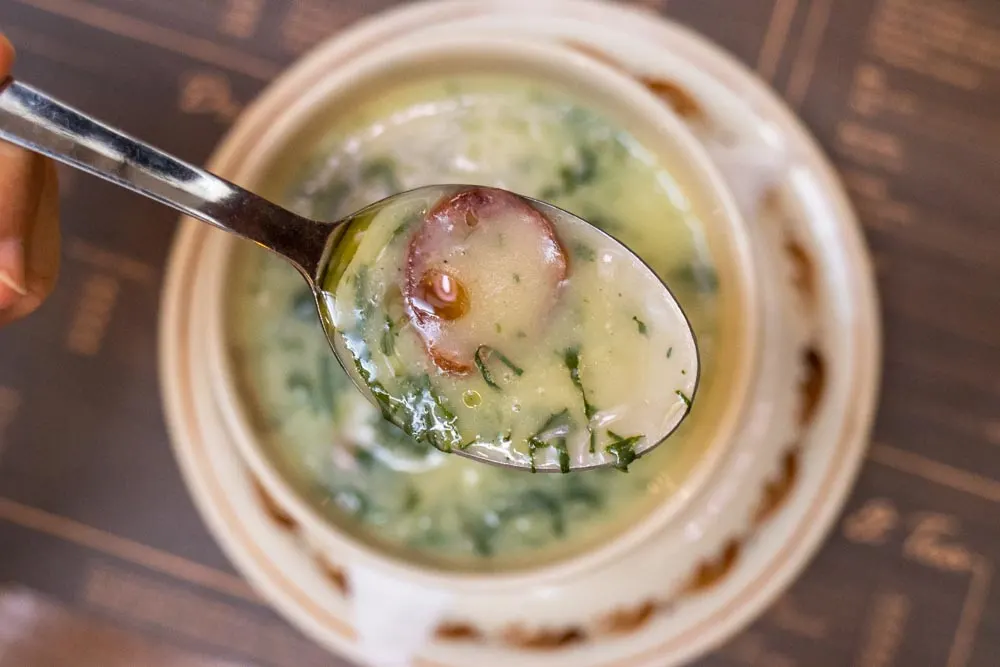
Caldo Verde translates to green broth but don’t let the literal translation turn you off. Originally from the north but popular throughout the country, Caldo Verde is a comforting, poor man’s soup typically made with potatoes, kale and olive oil.
Discover more of the best soups in the world.
Most bowls of Caldo Verde have a slice or two of chouriço added for a hint of smokey flavor and a bit of protein. While we covet these slices whenever we slurp the soup at home or in Portuguese restaurants, vegetarians and vegans can skip adding the meaty morsels to their bowls.
Pro Tip
Some restaurants only serve Caldo Verde on specific days of the week. Plan ahead to avoid disappointment.
8. Polvo à Lagareiro
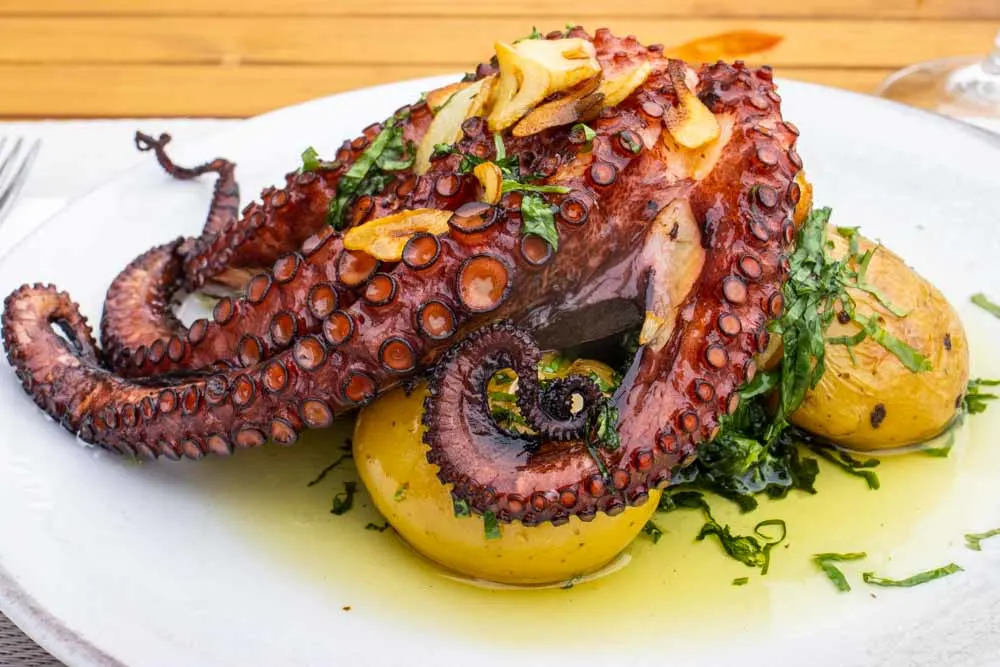
Octopus fans won’t want to miss eating Polvo à Lagareiro for dinner in Portugal. As implied by the dish’s name, Polvo à Lagareiro’s two main ingredients are octopus and olive oil. (Polvo translates to octopus and lagareiro refers to an olive oil producer.)
Nothing short of a show stopper, a plate topped with Polvo à Lagareiro typically displays the tentacled cephalopod atop a bed of roasted potatoes. Beyond octopus and olive oil, other ingredients include onion, garlic, bay leaves and salt.
Pro Tip
Indulge in Polvo à Lagareiro on Christmas Eve if you happen to be in Portugal for Natal.
9. Gambas a l’Ajilo
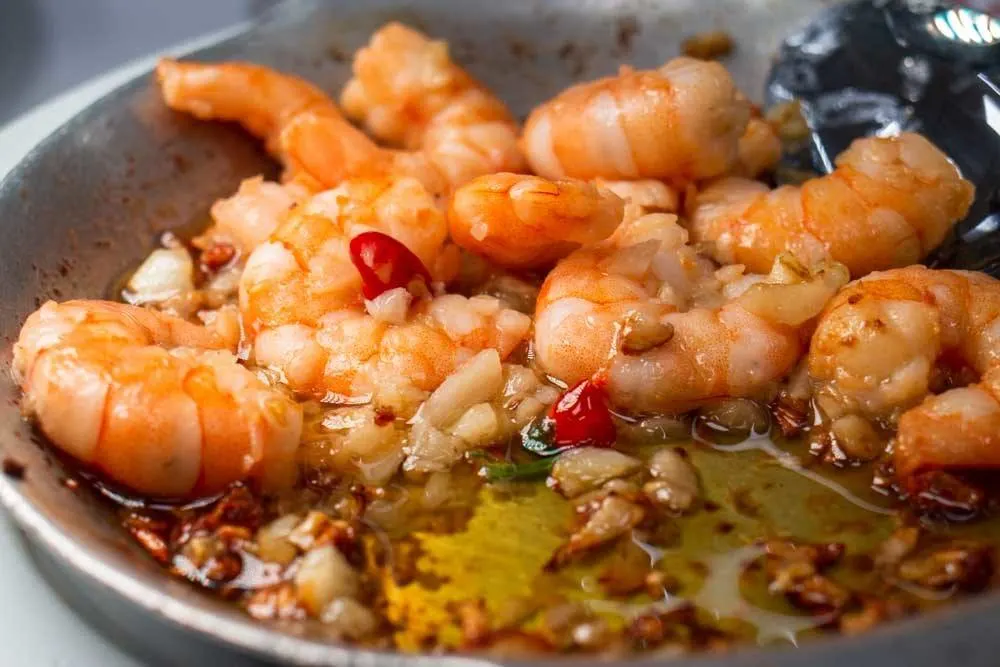
Gambas a l’Ajilo (garlic prawns) is one of our favorite dishes to eat in Portugal. The quality of the dish’s two main ingredients – garlic and prawns – are second to none in Portugal. The same can also be said for additional ingredients like olive oil and spicy peppers.
Although shrimp is available at most Portuguese markets, we’ve always eaten Gambas a l’Ajilo at marisqueiras (seafood restaurants). We plan on sautéing a batch at home soon.
Update: We were successful with our goal to make garlic prawns at home. The recipe is surprisingly easy and the result is divine.
Pro Tip
Make sure you have some pão (bread) to sop up the garlic sauce after you eat all the shrimp.
10. Cozido à Portuguesa
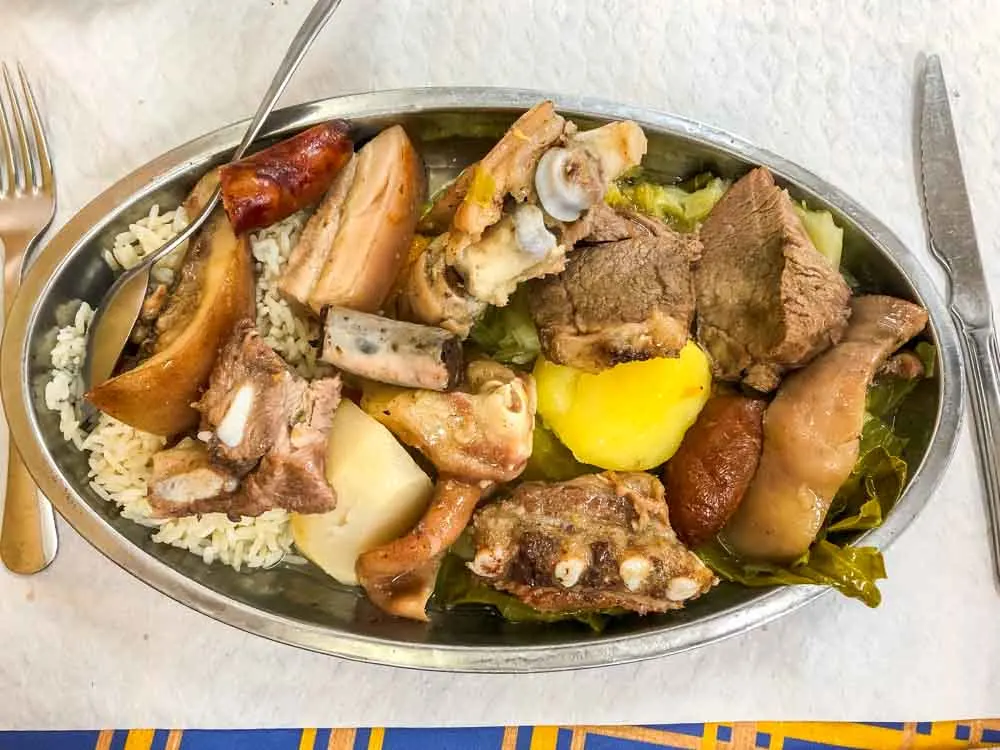
Cozido à Portuguesa is a great dish to eat after working in the fields all day. At least that’s how the iconic Portuguese dish was originally eaten. Today, people order the meaty meal at restaurants and tascas.
Not for dainty diners, Cozido à Portuguesa has all types of low and slow cooked Portuguese meat including ears, ribs, morcella (Portuguese blood sausage). chouriço and pork belly. The offaly melange is typically served with cabbage, rice and potatoes.
Fun Fact
Belcanto, the acclaimed Michelin-starred Chiado restaurant, offers a gastronomic version of Cozido à Portuguesa.
11.Frango Assado – Piri Piri Chicken
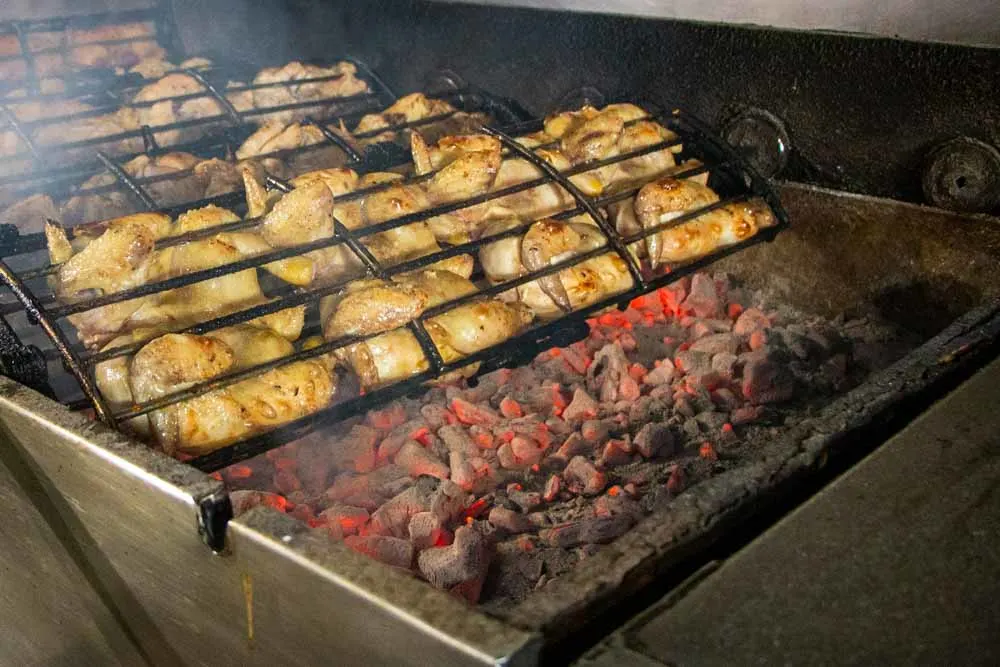
Just about every Portuguese neighborhood has a joint that sells Frango Assado to crowds who queue for grilled chicken every day of the week. However, when they order, they just say ‘Frango Piri Piri’ or ‘Piri Piri Chicken’.
The best Portuguese grill masters marinate butterflied chickens and then grill them at high heat. Upon request, they add additional marinade flavored with ingredients like olive oil, lemon juice and spicy piri piri oil.
Though not indigenous to Portugal, piri piri pepper is the magic ingredient that makes Frango Assado pop. Portuguese explorers brought the hot pepper back from southern Africa centuries ago and the rest is culinary history.
Fun Fact
The global restaurant chain Nando’s serves Piri Piri Chicken in more than 20 countries. Ironically, Portugal is not one of these countries.
12. Açorda
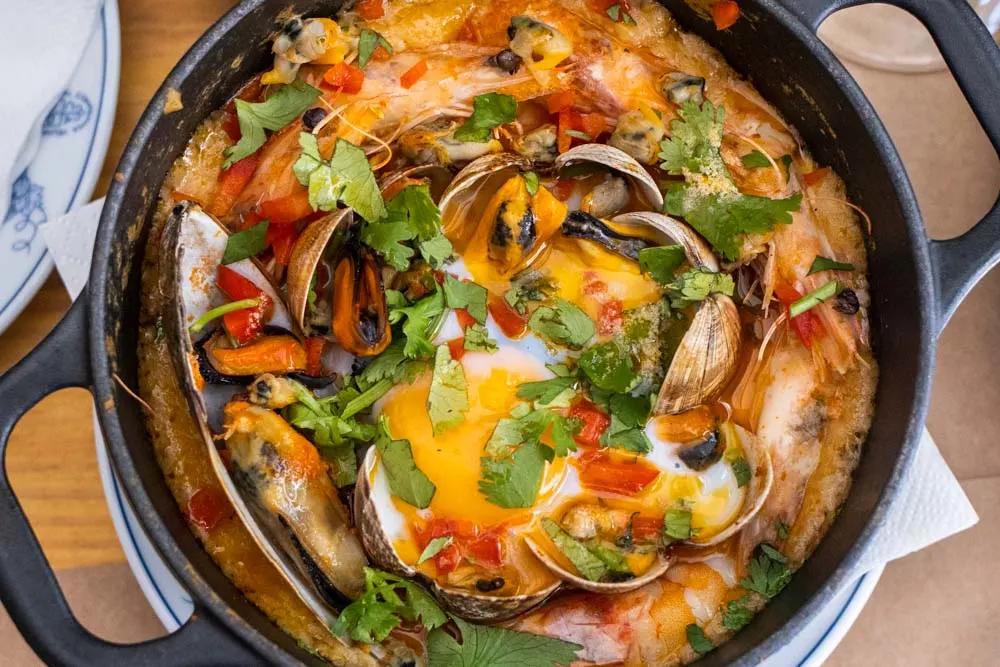
Some of the best foods in the world are rooted in poverty. Made with day-old bread and pantry staples, Portugal’s Açorda is one of these dishes.
In its simplest form and the way it was originally prepared in Alentejo, Açorda is a soup made with slightly stale bread, olive oil, garlic, vinegar, eggs and herbs. Some Portuguese chefs take the dish further by adding seafood to create a dish called Açorda de Marisco.
Follow our Shrimp Açorda recipe and cook the Portuguese rice dish at home.
13. Queijo
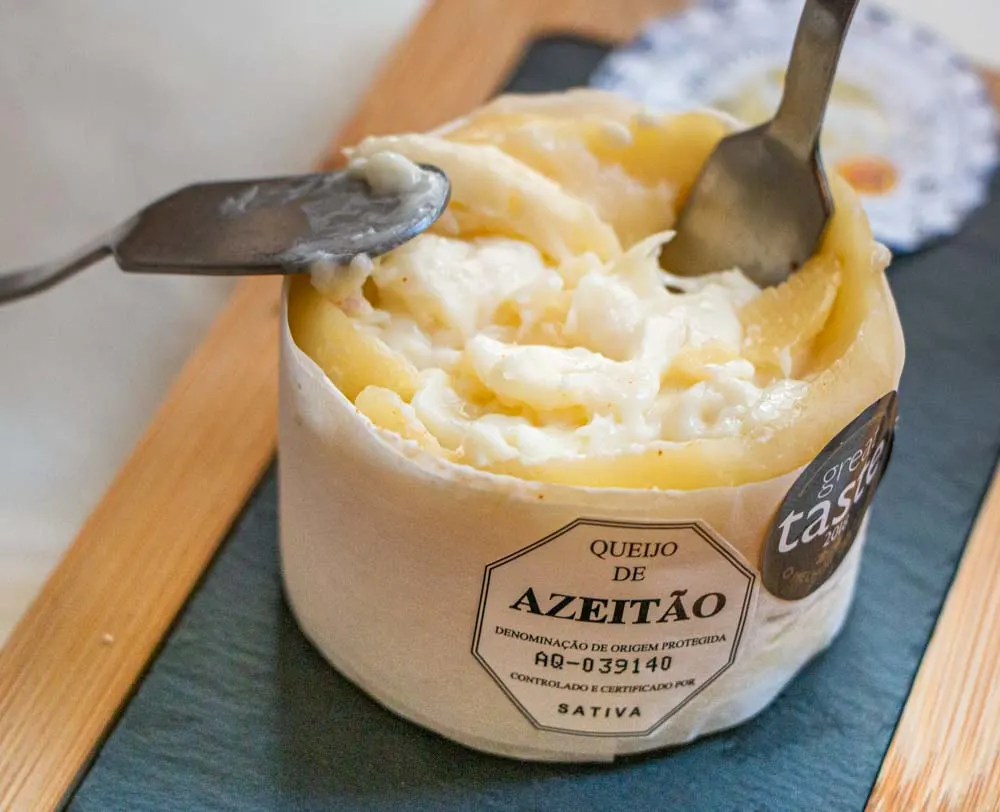
Though not as famous for its queijo (cheese) compared to other European countries, Portugal produces an enormous amount of cheese products. More than a dozen have achieved Designation of Origin (PDO) status.
Many Portuguese cheeses are small, cylindrical torta cheeses served with a spoon. Removing the top of the queijo reveals a spreadable silky, aromatic paste. Expect a unique tangy bite since coagulation of milk is traditionally achieved using thistle rennet.
A spreadable sheep cheese called Serra da Estrella, produced in a mountainous region northeast of Coimbra, is the country’s most lauded cheese. We’re partial to Queijo de Azeitão, an equally spreadable sheep milk cheese that’s produced in the Setubal district near Lisbon.
Pro Tip
There’s only one way to find out which Portuguese cheese is YOUR favorite. We recommend conducting research along with copious amounts of Portuguese wine.
14. Chouriço Assado
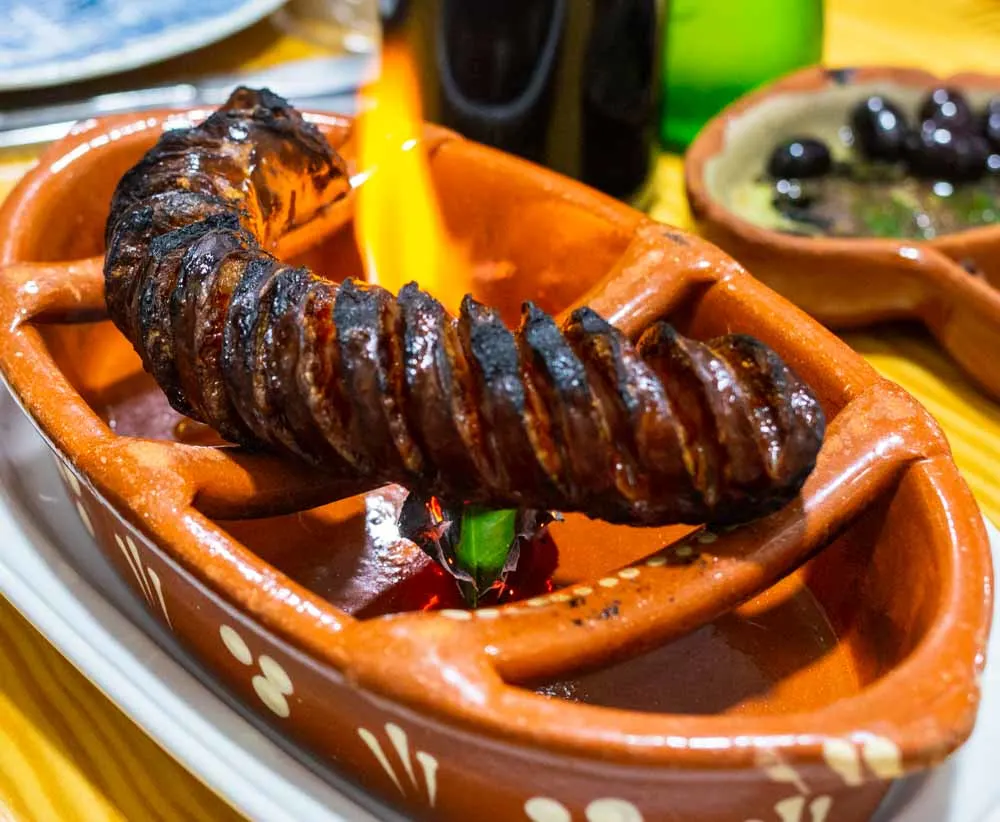
More than just an ingredient in dishes like Arroz de Pato and Caldo Verde (see both above), chouriço is one Portugal’s finest food products. A close cousin to Spanish chorizo, Portugal’s version is a little smokier and a little more rustic with large specks of fat.
Markets sell packs of chouriço to eat at home but the best way to eat the local meat is by ordering Chouriço Assado at a bar. This dish typically arrives in a clay dish with the chouriço literally on fire.
Pro Tip
Please multiple senses by ordering Chouriço Assado at a Fado bar. Your mouth and ears will both be happy.
15. Porco Preto
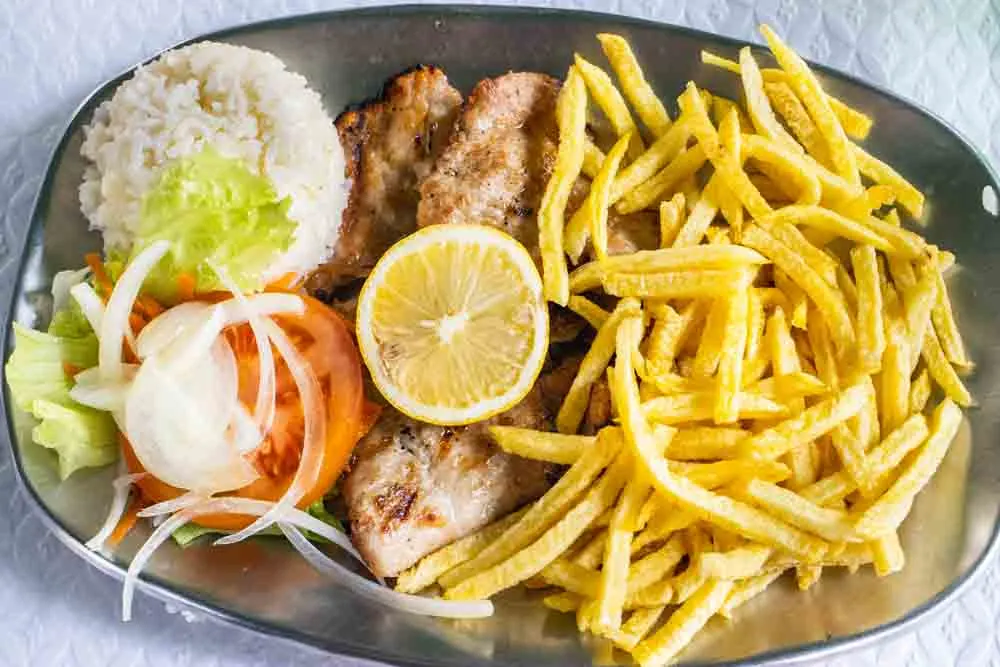
Porco Preto (black pigs) live a good life in Alentejo. When they’re not munching on bolotas (acorns), they’re roaming free in Portugal’s gorgeous countryside. As a result of this lifestyle, Porco Preto meat, fatty and with a slightly nutty flavor, is considered to be among the best pork in the world.
Butchers, markets and grocery stores sell Chouriço Porco Preto. The charcuterie pairs especially well with Portuguese cheese and wine from Alentejo.
Restaurants serve cooked versions like Secretos – a particularly tasty cut ‘hidden’ under the pork belly of these precious black pigs. When we see this juicy, flavorful dish on a Portuguese menu, we almost always order it. It’s that good.
Fun Fact
Spain’s Porco Iberico is famous around the world, far more famous than Portugal’s Porco Preto. Ironically, many of Spain’s black pigs pigs are raised in Alentejo and eat the same acorns as Portugal’s black pigs.
16. Alheira
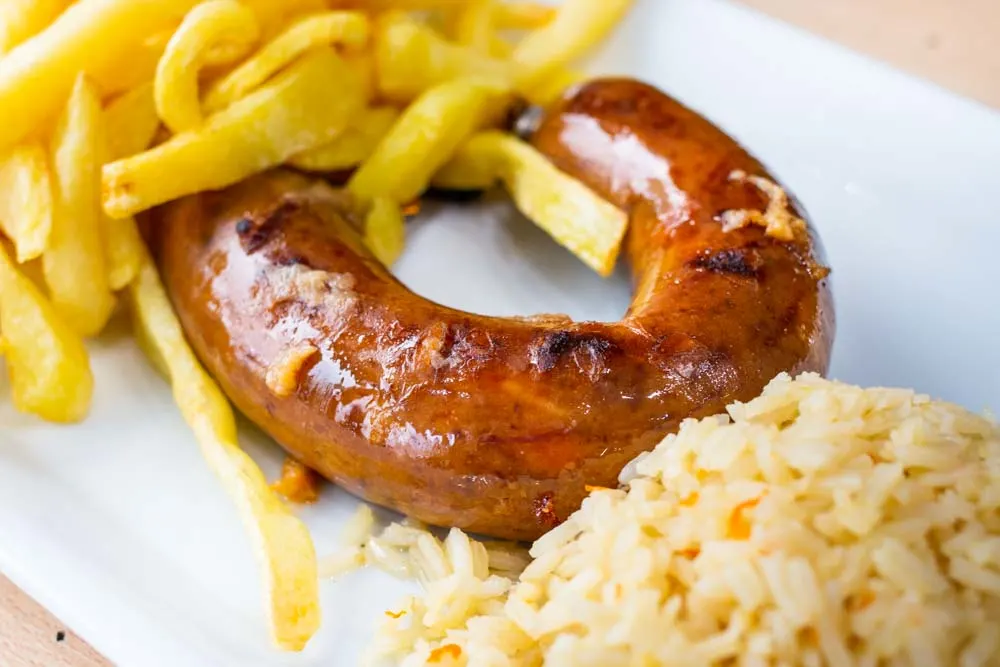
People who don’t eat pork are in for a treat in Portugal and that treat is called Alheira – a Portuguese ‘farce’ with a juicy story…
Centuries ago, Portuguese Jews were forced to convert to Catholicism during the Inquisition to avoid persecution. They ate Alheira during that dark time to demonstrate their conversion to the Christian faith. However, while it looked like sausage, Alheira was actually stuffed with beef, poultry or game meat and was therefore kosher.
Centuries later, Alheira, with a texture reminiscent of Eastern European Kishka, is now more prevalent in Portugal than the few Jewish people who remained in the country after the Inquisition. Tascas and other casual restaurants typically top Alheira with a fried egg and serve the dish with rice and potatoes.
Pro Tip
Don’t hesitate to order Alheira if you follow a kosher diet. However, this Portuguese food favorite is not typically vegetarian or vegan.
17. Choco Frito
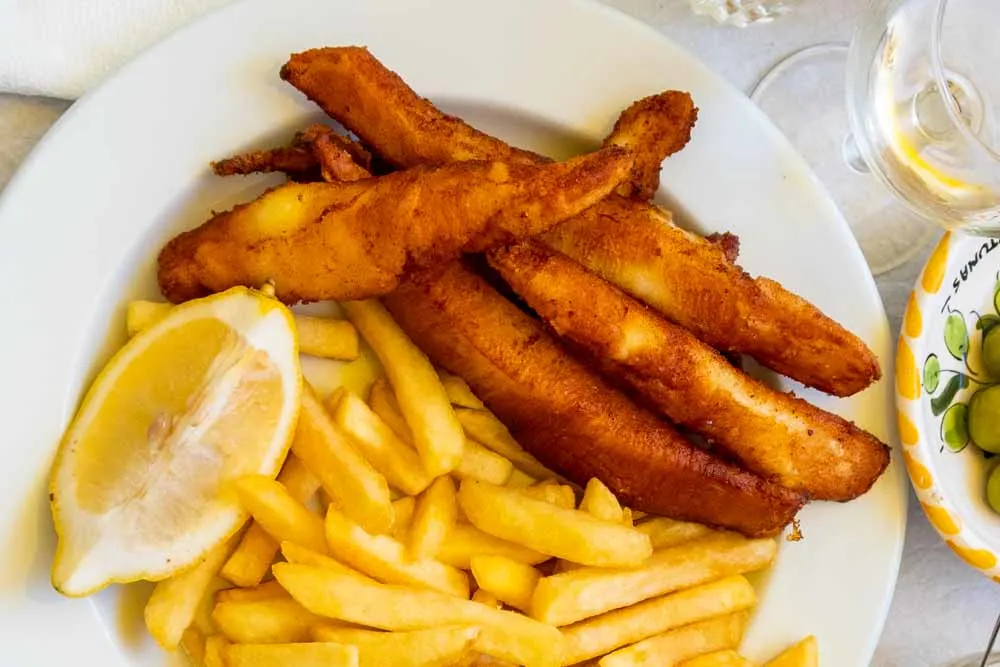
Choco Frito is a hyper local Portuguese food favorite that’s specific to one city – Setubal. A stroll through the charming seaside town reveals a slew of local restaurants that offer Choco Frito as the featured dish on their menus.
But what is it? Despite a name that seems to involve fried chocolate, choco frito translates to fried cuttlefish and that’s exactly what this dish is.
Setubal cooks bread and fry thick, finger-size chunks of giant cuttlefish that’s unique to the region and plate them with fried potatoes. The dish is fun to eat and pairs well with Portuguese white wine.
Pro Tip
Squeeze some fresh lemon on your Choco Frito to brighten the dish’s flavor.
18. Caracóis
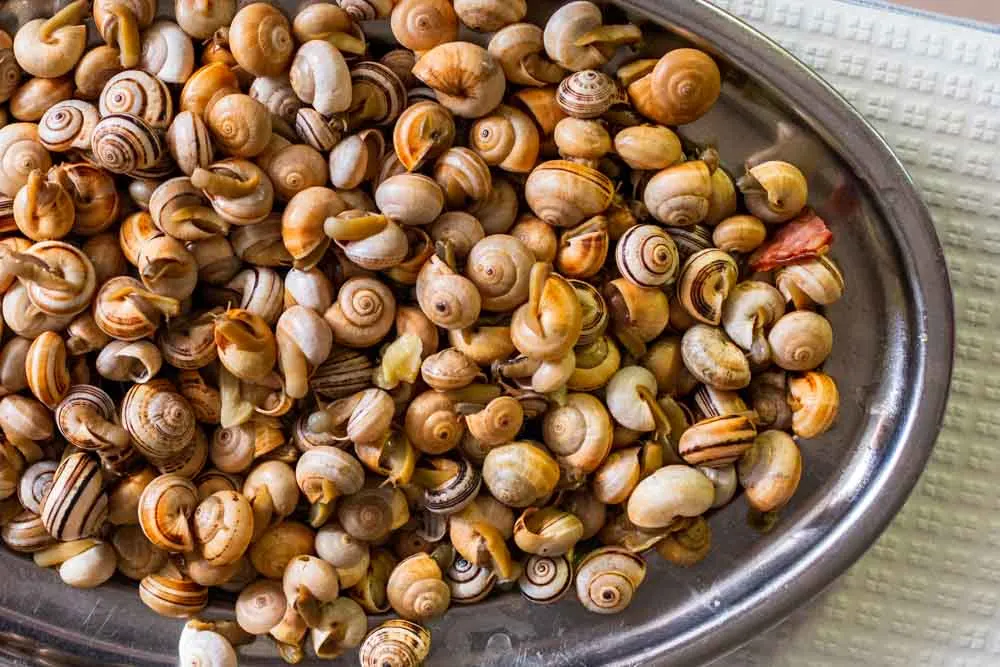
From May until September, Portuguese friends meet to eat heaping plates of caracóis (snails) with cerveja (beer) and pão (bread). Yes, the sardine isn’t the only summertime star in Portugal.
Portuguese tascas typically serve the tiny mollusks in a flavorful broth along with equally tiny toothpicks. Part of the fun is hunting for the meat in each snail. The other fun part is mopping up the sauce with bread and washing it all down with beer.
Pro Tip
Order caracoletas if you prefer eating larger snails similar in size to French escargots.
19. Peixinhos da Horta
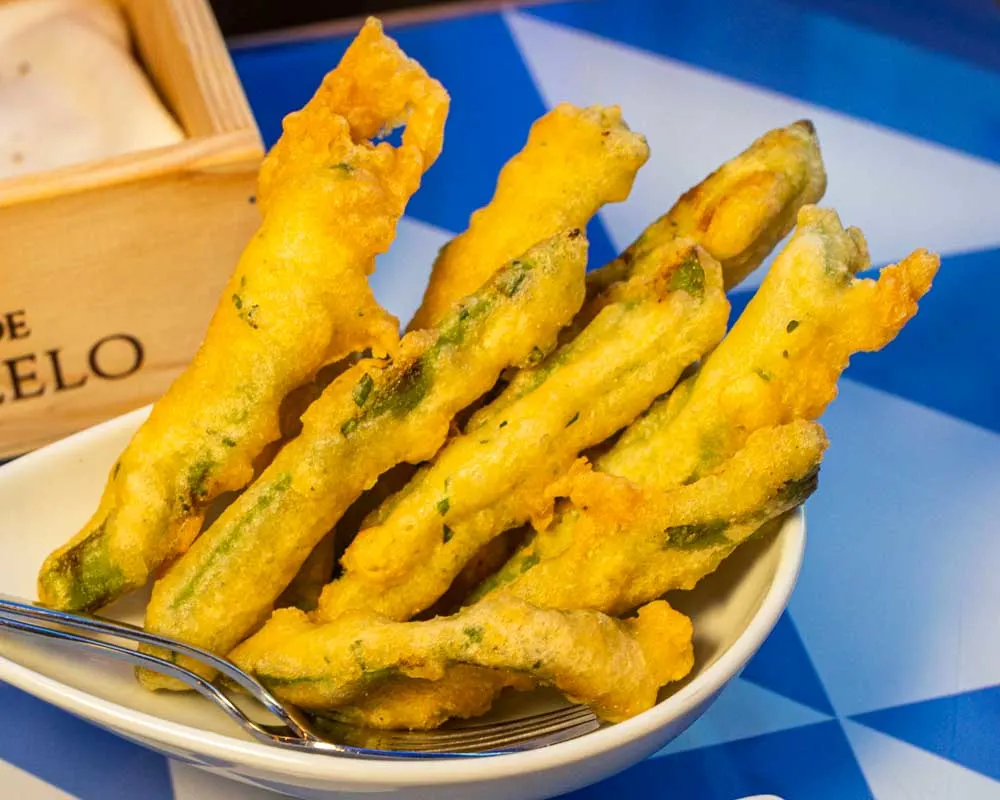
Food travelers will be fascinated by Portugal’s tasty Peixinhos da Horta. These breaded and fried green beans don’t just look like tempura. They’re actually the inspiration for the Japanese food favorite!
History reveals that the Portuguese have been frying breaded green beans for centuries. Portuguese missionaries introduced the dish to Japan in the 16th century.
Despite a name that literally translates to little fish from the garden, Peixinhos da Horta is a vegetarian dish. The fish connotation refers to the dish’s shape and not its ingredients. Beyond its fun name and fascinating history, it’s also one of the best Portuguese side dishes as well as one of our favorite Portuguese vegetable dishes.
Pro Tip
You don’t need to avoid Peixinhos da Horta if you’re not a green bean fan. Portuguese chefs occasionally use other garden vegetables to make this popular Portuguese side dish.
20. Tripas à Moda do Porto
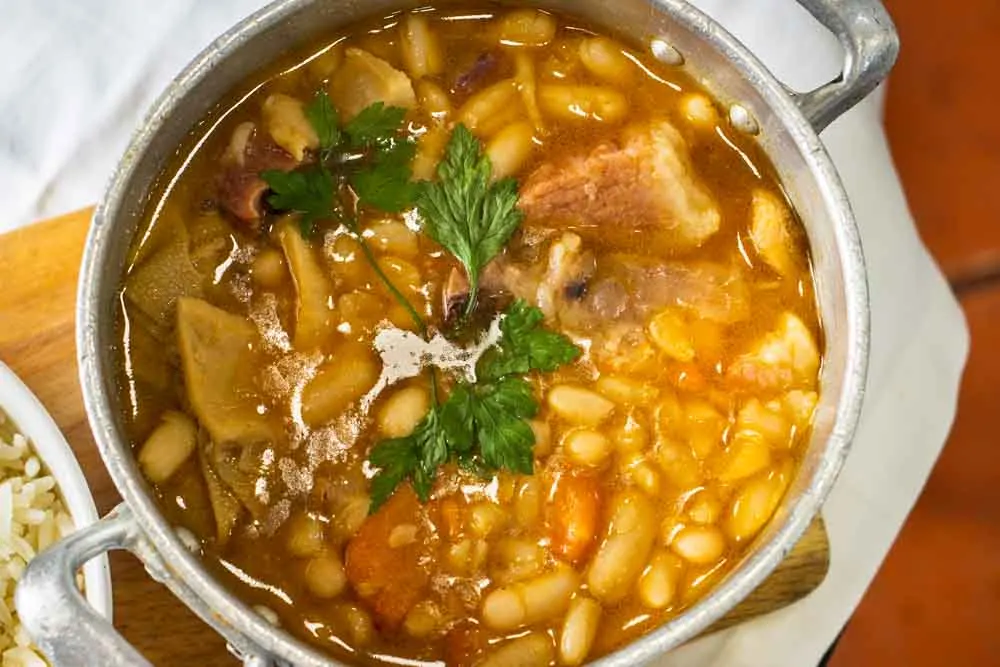
Considered to be one of Portugal’s seven gastronomic wonders, Tripas à Moda do Porto isn’t for everybody due to its main ingredient.
But adventurous eaters won’t want to miss this tripe dish when they visit Porto, the city where it was invented during the Middle Ages. This dish was so important in Porto back in the day that residents of the northern city are called Tripeiros.
The Tripas à Moda do Porto recipe has evolved over the centuries. In addition to beans discovered by Portuguese explorers, typical ingredients include veal, pork, chicken, carrots, bay leaves, onion and garlic.
Pro Tip
Most tascas prepare and serve Tripas à Moda do Porto on specific days of the week. Plan ahead to avoid disappointment
Portuguese Sandwiches
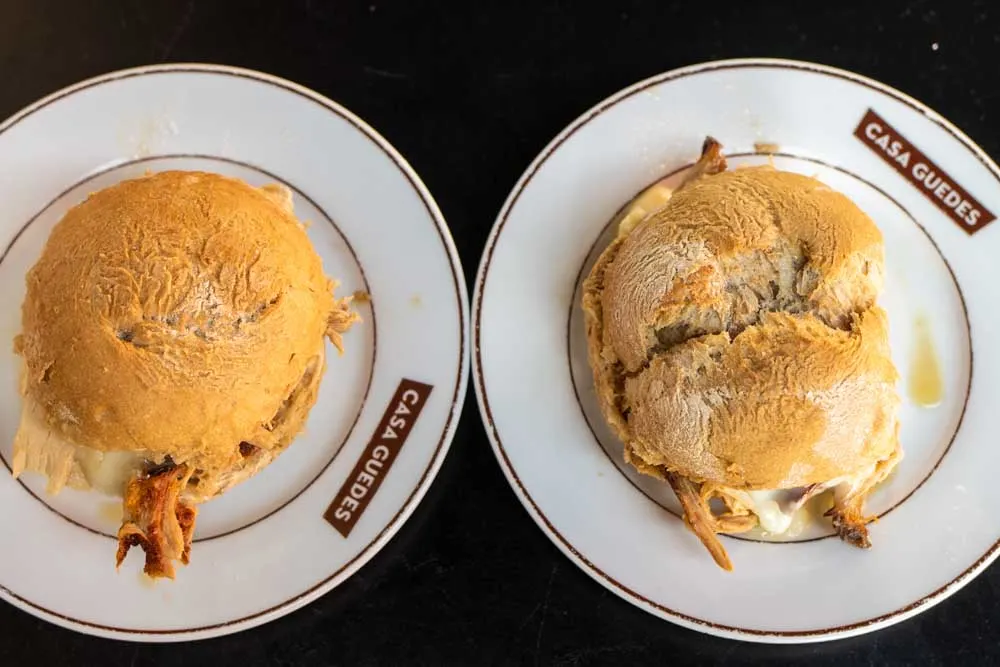
The Portuguese have a thing for sandwiches and so do we. There’s nothing better than food on the go especially if it’s tasty and cheap. Not only do Portuguese sandwiches taste great, they’re also some of the country’s best cheap eats.
Read about the best sandwiches in the world.
After eating sandwiches around the world, these are our four favorite Portuguese sandwiches and the ones you need to try:
21. Francesinha
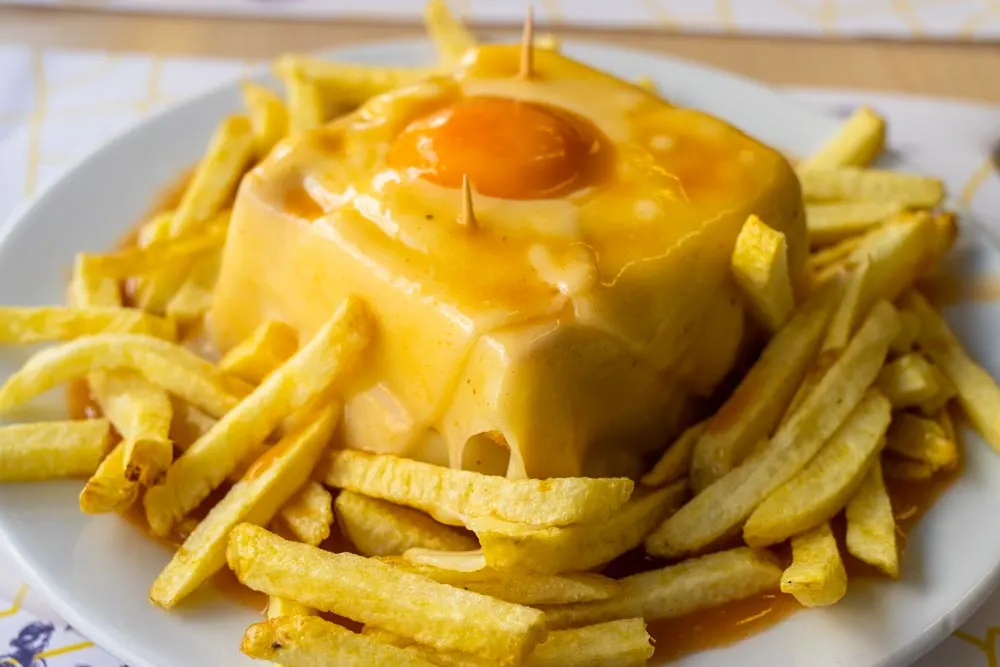
The Francesinha isn’t just one of Portugal’s best sandwiches and one of the most iconic foods from Porto. The unusual sandwich is big enough to be a meal. And that’s not counting french fries.
Invented in Porto and allegedly inspired by France’s Croque Monsieur, a Francesinha is a monster of a sandwich with with meaty ingredients like steak, ham, chourićo and sausage. But here’s where the sandwich gets its uniqueness – the whole thing gets covered with melted cheese, smothered with tangy tomato sauce and topped with a fried egg.
If you’re looking for the perfect food after a day of wine tasting in Vila Nova de Gaia, this is it.
Pro Tip
Don’t even try to eat a Francesinha with your hands. You’ll want to eat this bad boy with a knife and fork.
22. Bifana
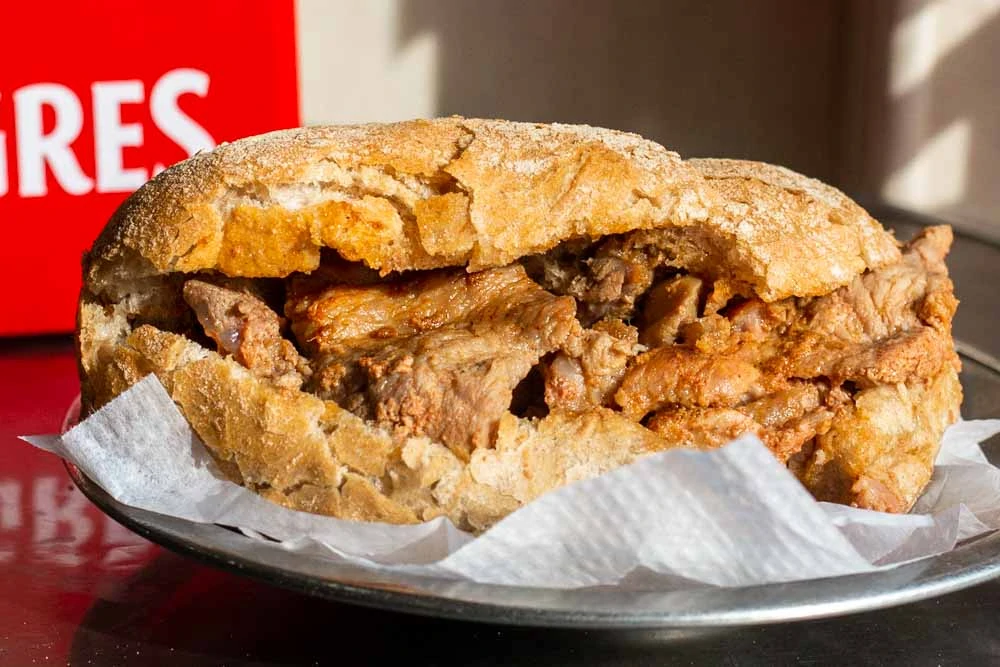
When Portuguese people grab a quick lunch on the go, it’s likely that lunch will involve a Bifana. This sandwich is that prevalent throughout the country.
Both simple and satisfying, a Bifana is essentially sautéed pork slices stuffed inside a roll. The best Bifana stands cook the pork low and slow, making the addition of mustard or piri-piri sauce less of a necessity and more of a complement.
Pro Tip
Order an Imperial to go with your Bifana. A small glass of refreshing Portuguese ‘swill’ beer like Sagres or Super Bock will pair perfectly with your sandwich.
23. Prego
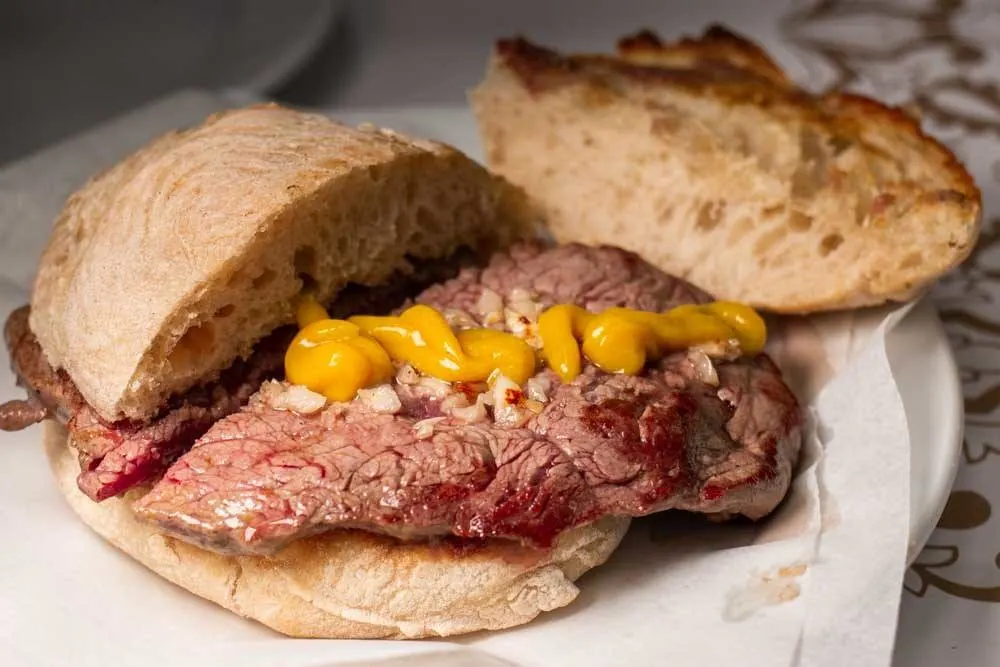
Sandwich fans who don’t eat pork have a great option – a Prego made with steak instead of pork. But not just plain steak. Cooks sauté steak with ingredients like garlic, onions and wine before stuffing it inside a roll.
Portuguese typically eat two types of Prego sandwiches. The first, Prego no Pão, is all about the meat. Those looking for a more decadent sandwich specify com ovo if they want a fried egg added as well.
Pro Tip
Order a Prego to end your seafood meal at Cervejaria Ramiro in Lisbon. Don’t ask questions. Just do it.
24. Pernil com Queijo
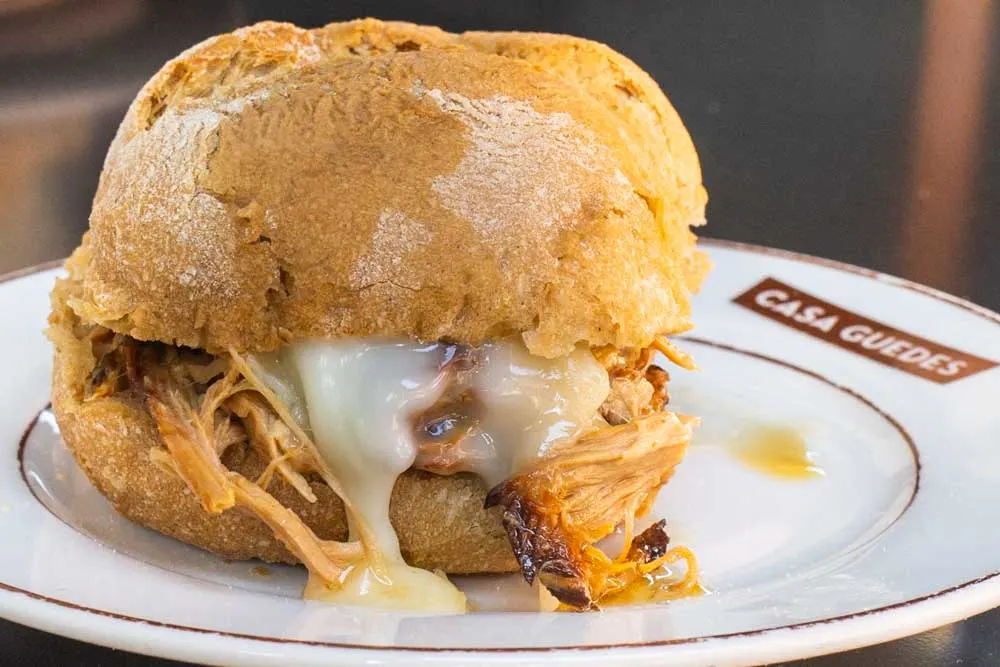
The Pernil com Queijo sandwich wasn’t on our radar until we visited Porto. After one bite, we wondered where the sandwich had been all our lives.
Pernil com Queijo translates to ham with cheese but this sandwich is so much more than its simple name implies. Cooks stuff crispy rolls with slow-cooked pork leg and ooey-gooey Serra da Estrela cheese to make Pernil com Queijo sandwiches. The combination tastes like a dream.
Pro Tip
If you’re debating between getting a Pernil instead of a Pernil com Queijo, go for the latter. The cheese elevates this great sandwich to legendary status.
Portuguese Pastries and Dessert

Bakers in Portugal show little restraint when it comes to adding sugar and egg yolk to their recipes. As a result, Portuguese pastries are sweeter than pastries in Paris and other European cities. The same applies to Portuguese desserts.
Portuguese people are okay with this situation. They often start their days with pastries and end them with dessert. And that doesn’t contemplate occasional midday indulgences!
If you’re feeling overwhelmed by the many pastries and deserts in Portugal, we recommend starting with these iconic Portuguese sweet treats:
25. Pastel de Nata

The Pastel de Nata has been Portugal’s signature pastry since Fábrica de Pastéis de Belém opened in 1837. Located on the outskirts of Lisbon, the famous pasteleria uses a secret recipe created by monks at the nearby Mosteiro dos Jerónimos during the 18th century.
Those clever monks used egg yolks leftover after using the whites to starch habits and other religious garments. They also used plenty of sugar and cream. The result is a tasty egg tart that pairs well with coffee.
Although you can only eat the original version in Belém, you’ll never be far from a Pastel de Nata in Portugal. Almost every single pasteleria sells Pastéis de Nata and they pretty much always taste great.
Read our Lisbon Pastel de Nata guide.
26. Travesseiros
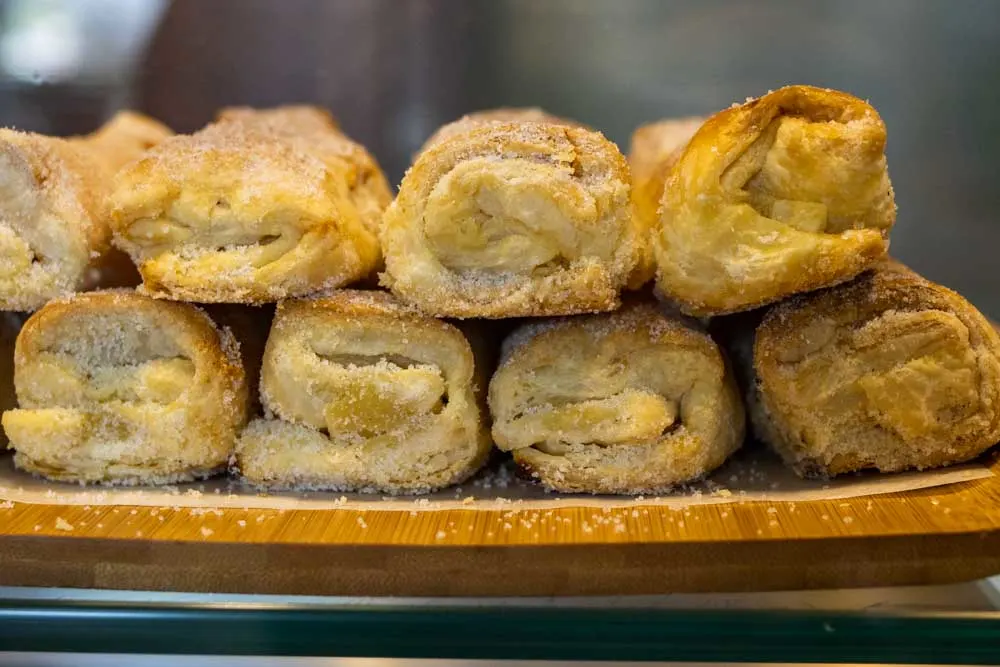
Most Portuguese cities have one signature pastry. Despite its relatively small size, Sintra actually has two. The Queijada de Sintra is great but the Travesseiro is the Sintra pastry not to miss.
Lines form daily to buy Travessieros at Piriquita every day. Open since 1861, the Sintra bakery invented the pillow-like pastry in the 1940s using typical Portuguese ingredients – egg yolk and sugar. The addition of almonds and puff pastry make this pastry special.
Get tips on what and where to eat during a Sintra day trip.
27. Ovos Moles

Ovos mole translates to soft eggs, an apt name for the convent pastry popularized by nuns in Aveiro more than a century ago. Not surprisingly, the Ovos Mole recipe has a healthy amount of both egg yolks and sugar.
Aveiro’s over-achieving nuns went an extra step by surrounding their sweet, eggy concoction with communion wafers. Their Ovos Mole is so unique that it received protected status from the European Union.
Pro Tip
One Ovos Mole is more than enough. You’ll risk a sugar high if you eat two or more.
28. Arroz Doce
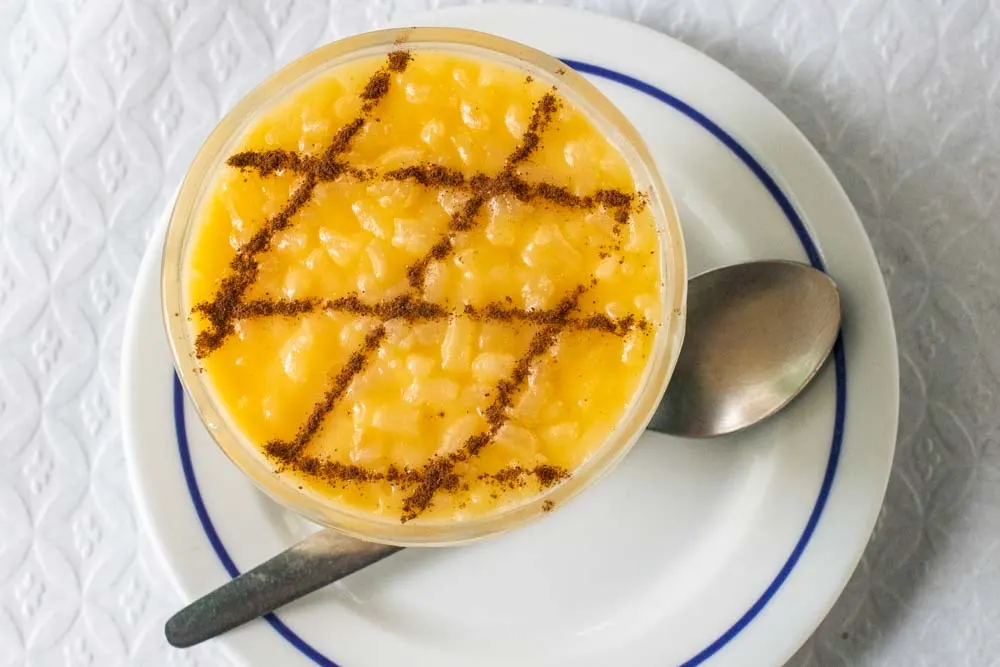
Despite the vast number of Portuguese pastries, the Iberian country also has a number of desserts in its sweet arsenal. Arroz Doce is a favorite of many including us.
As its name suggests, Arroz Doce is a sweet rice pudding similar to desserts eaten in coutries like Spain, India and Greece. Typical ingredients include short-grain rice, milk and lemon peel in addition to egg yolks and sugar.
Discover our picks for the best desserts and pastries in Portugal.
Portuguese Drinks

Eating your way around Portugal will inevitably create a thirst that can’t be denied. Let’s face it – the best Portuguese dishes aren’t exactly salt-free.
If you you’re wondering what to drink in Portugal, the answer is whatever you want. While the country is famous around the world for its fortified wine, Port is just one popular thing to drink in Portugal.
We recommend starting with the following Portuguese drinks:
29. Cerveja (Beer)
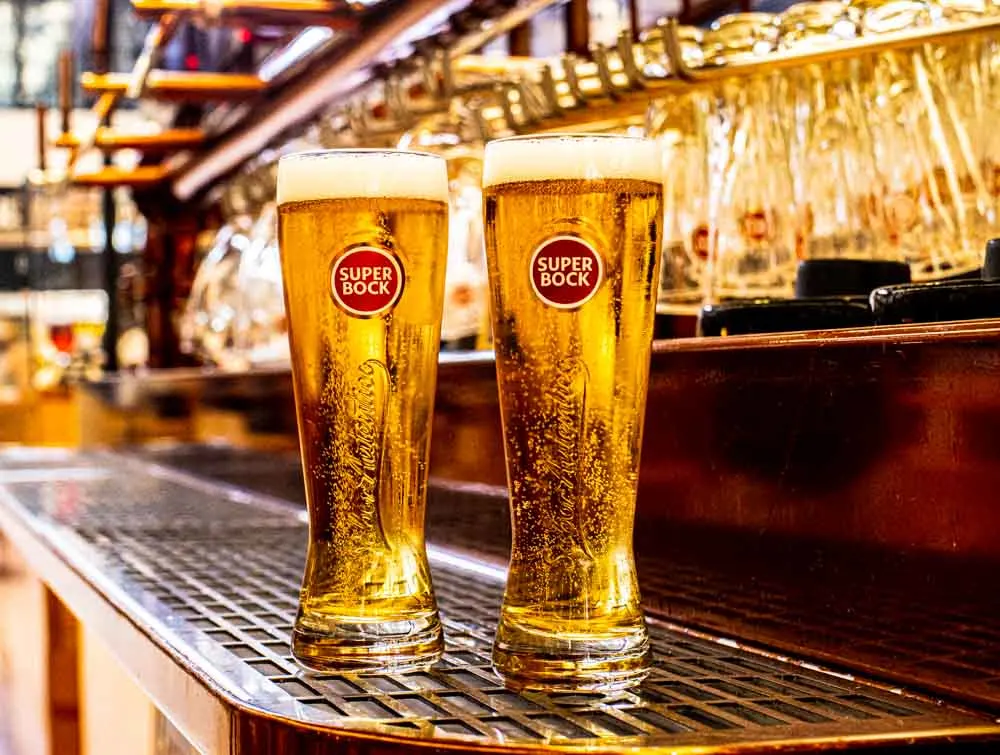
When you’re thirsty for beer in Portugal, you won’t have to look hard to find Cerveja on a Portuguese menu. The hoppy beverage is sold everywhere in the country from the most humble tascas to the finest dining establishments.
This popularity is nothing new. The Portuguese people have been drinking beer for centuries. The country’s two biggest breweries, Sagres and Super Bock, produce lagers that are easy to drink without breaking the bank. Try them both to find your favorite.
Good news for Craft Beer aficianados! Great craft beer producers have emerged in both Lisbon, Porto and throughout Portugal. Look for great options from breweries like MUSA and AMO in Lisbon as well as Sovina in Porto.
Pro Tip
Explore Portugal’s burgeoning craft beer scene by taking a self-guided beer crawl in Lisbon’s trendy Marvila neighborhood.
30. Vinho (Wine)
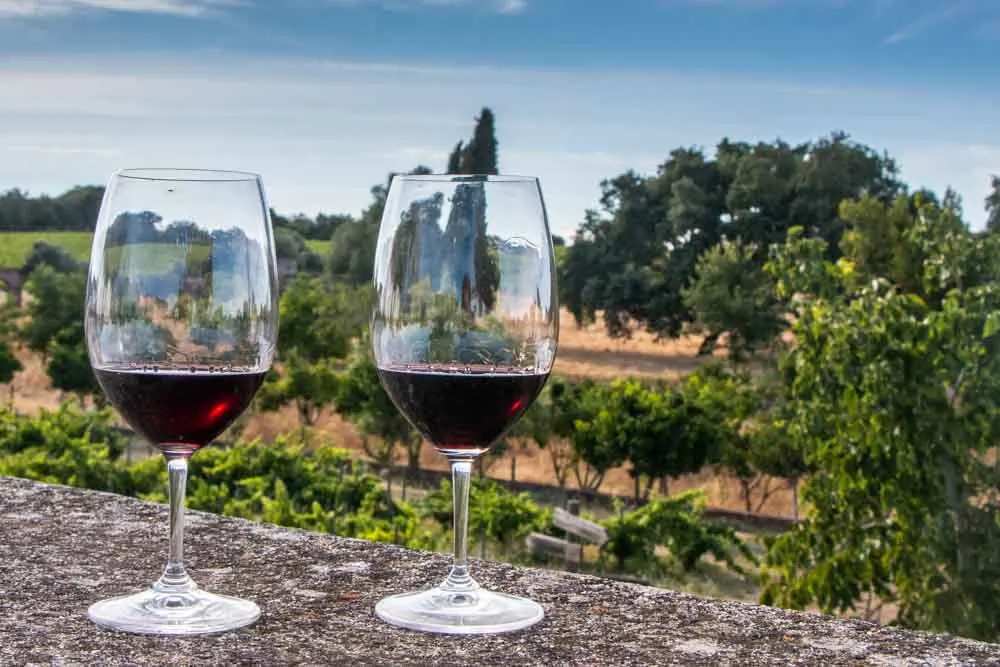
Flying under the vitaculture radar, Portugal produces wine that’s a pleasure to drink every day of the week. Portuguese winemakers export a good bit, but, as is the case in most countries, they keep the best bottles within their borders.
While Vinho Verde may be the country’s most famous wine varietal, red and white wines produced in regions like Alentejo, Dão and the Douro compare favorably to wine produced around the world. And the best part, wine in Portugal is one of the country’s greatest bargains.
Pro Tip
Order a glass, carafe or bottle of wine when you dine at a Portuguese restaurant.
31. Port Wine
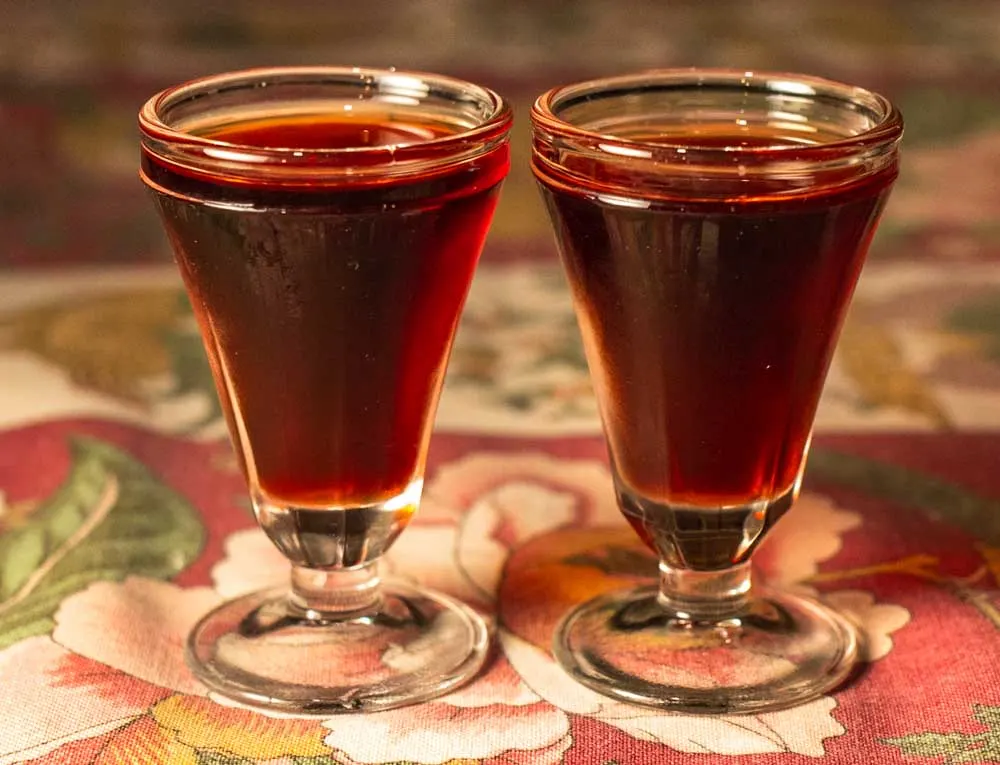
Many countries produce fortified wine but Portugal is the only country that can produce Port Wine. Portuguese winemakers have been producing the protected beverage in the Douro Valley for centuries.
Plan to end your evenings with small glasses of Port while you’re in Portugal. Better yet, visit one or more Port house in Porto and taste ruby, tawny, white and vintage Port. Once you find your favorite, you’ll want to buy a bottle or two to take home as drinkable souvenirs.
Follow our Porto Tonico recipe and craft the white port and tonic cocktail at home.
32. Ginjinha
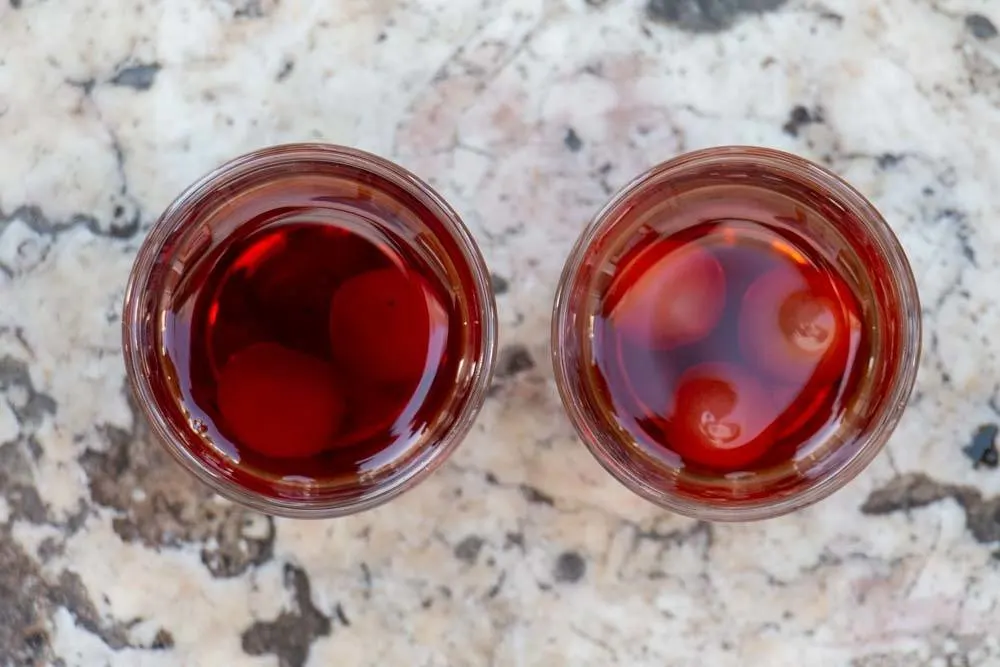
Cherry fans will want to drink Ginginha (also called Ginja) in Portugal. Available throughout the country, the sour cherry liqueur is especially easy to find in Lisbon, Óbidos and Alcobaça.
Ginjinha’s ingredients include sour ginja (morello) cherries as well as alcohol, sugar, cinnamon and cloves. If you see Ginjinha served in miniature chocolate cups – order a shot or two. In case you aren’t already aware, cherries and chocolate are a match made in culinary heaven.
Pro Trip
Be aware that Ginjinha is as strong as it is sweet. The ABV exceeds 20%.
33. Café (Coffee)
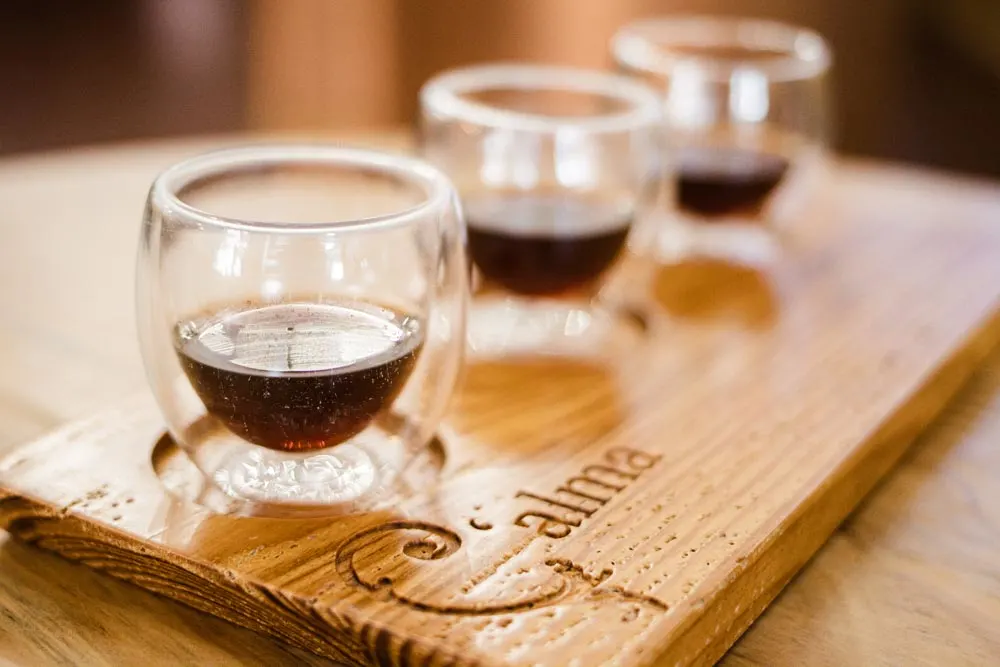
Commodity coffee made with robusta beans is cheap and plentiful in Portugal. A bica (espresso) rarely costs more than a euro and often less. Accordingly, the Portuguese drink a lot of coffee both at neighborhood cafes and at home.
After traveling the world in search of great coffee, we were pleased to find vibrant specialty coffee scenes in both Lisbon and Porto. Accordingly, we skip the cheap stuff and drink quality flat whites and pour-overs in these cities. What type of coffee you drink in Portugal is up to you.
Read our guides to drinking specialty coffee in Lisbon and Porto.
Frequently Asked Questions
Portugal’s Pastel de Nata is famous around the world. The creamy custard tart isn’t just delicious. It’s also one of Portugal’s Seven Wonders of Portuguese Gastronomy
Bacalhau à Brás made with dried, salted cod, onions and potatoes is the most traditional Portuguese dish to eat in Portugal. Other traditional Portuguese dishes include Polvo à Lagareiro (octopus with olive oil and potato), Porco Preto (black pork), Sardinhas Assadas (grilled sardines) and Arroz de Pato (duck rice).
No. Tipping is optional in Portugal.
Although Port Wine can only be produced in Portugal’s Douro Valley, the fortified wine is famous around the world.
Video Recap
Check out our guide to eating in Portugal as well as our picks for the best Portuguese desserts before your trip.

About the Authors
Daryl and Mindi Hirsch
Saveur Magazine’s BEST TRAVEL BLOG award winners Daryl and Mindi Hirsch share their culinary travel experiences and recipes on the 2foodtrippers website. Since launching the site in 2012, they’ve traveled to over 40 countries in their quest to bring readers a unique taste of the world.
Original Publication Date: December 20, 2020

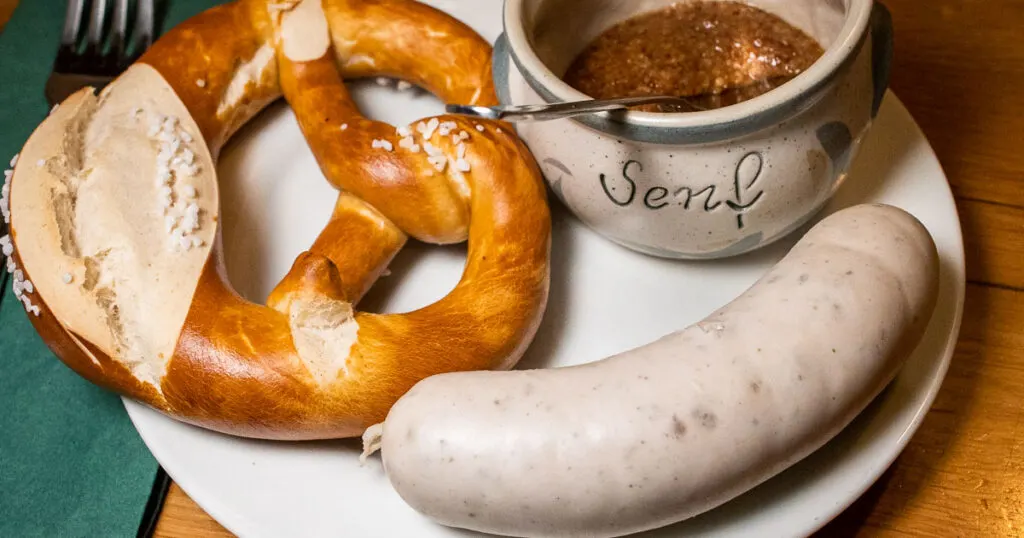
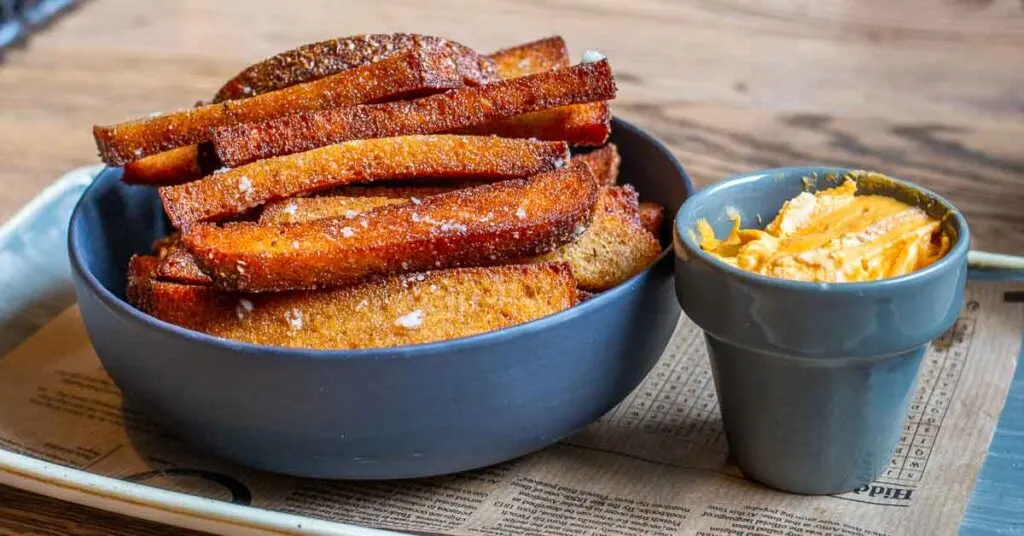

Luna
Saturday 2nd of March 2024
You can't eat olives right from the tree, they need to be cured/brined in water, salt and spices for at least a few days. After that they can be kept in the fridge, but the best way is to can them. That's why you'll never find fresh olives.
Daryl and Mindi Hirsch
Tuesday 12th of March 2024
We know this. We're referring to something completely different. We totally know that one must cure and brine olives before eating them.
Baron W
Sunday 16th of October 2022
Very disappointing that you do not mention any Azorean ingredients, especially considering how these are held in the highest esteem in Portugal and considered to be local premium products on the mainland. Mentioning Horta's green beans doesn't cut it.
Gloria
Saturday 15th of October 2022
Hi Daryl and Mindi, It looks like your picture of Bacalhau à Brás is in fact Bacalhau com Natas. Both are delicious dishes but are very different presentations of bits of cod fish. Thanks!
Daryl and Mindi Hirsch
Tuesday 12th of April 2022
Thanks for your feedback but perhaps the issue is with your device. We have already included the correct spelling in our article. Cheers!
Ana Costa
Sunday 26th of December 2021
Hello, I just noted a little error, Portugal and Spain where never the same country. I hope you enjoy living there. From a portuguese that left to Canada.